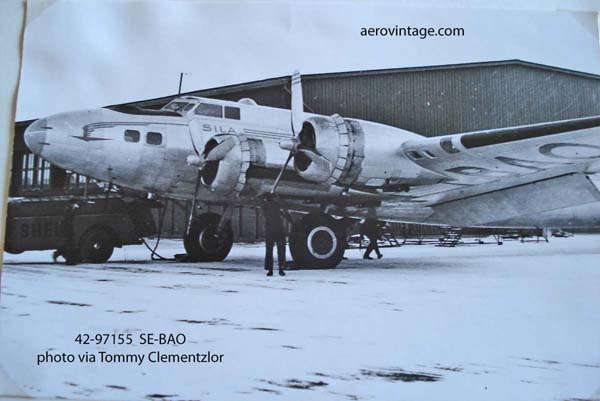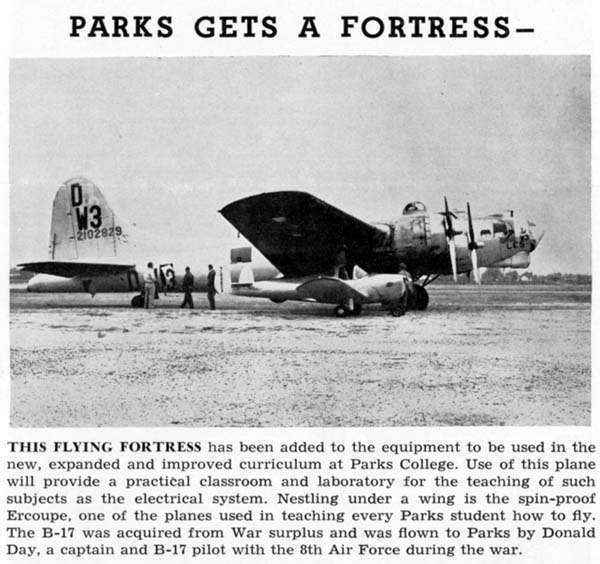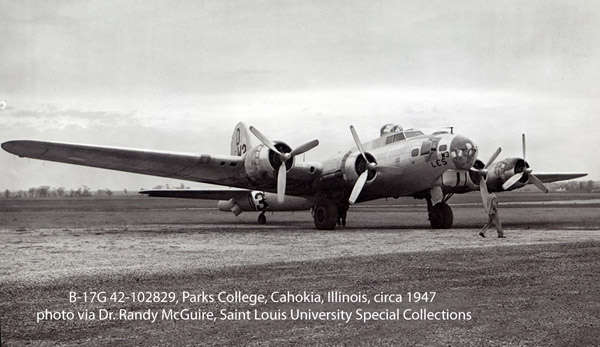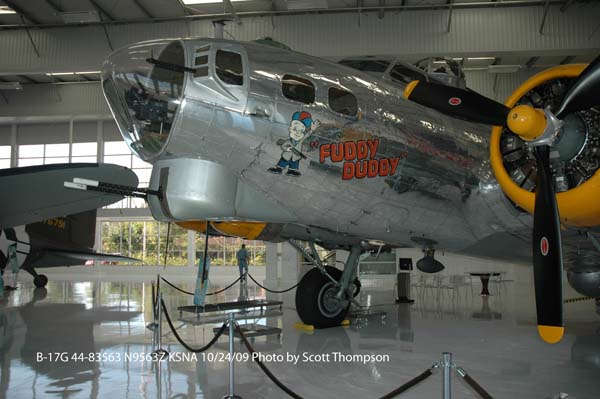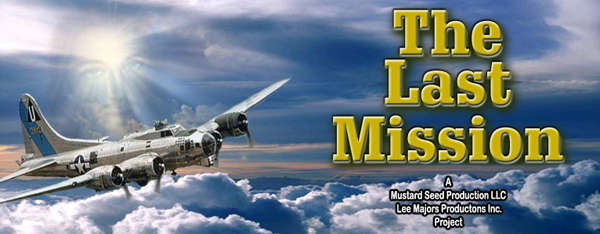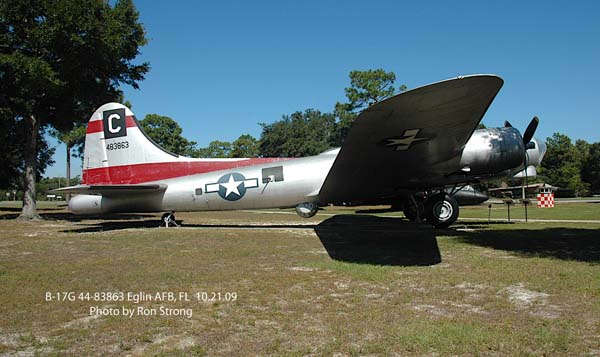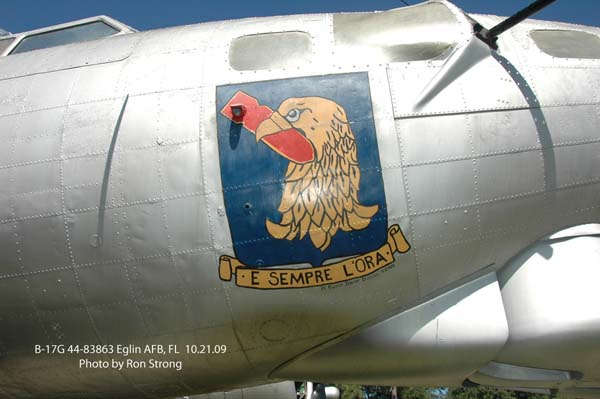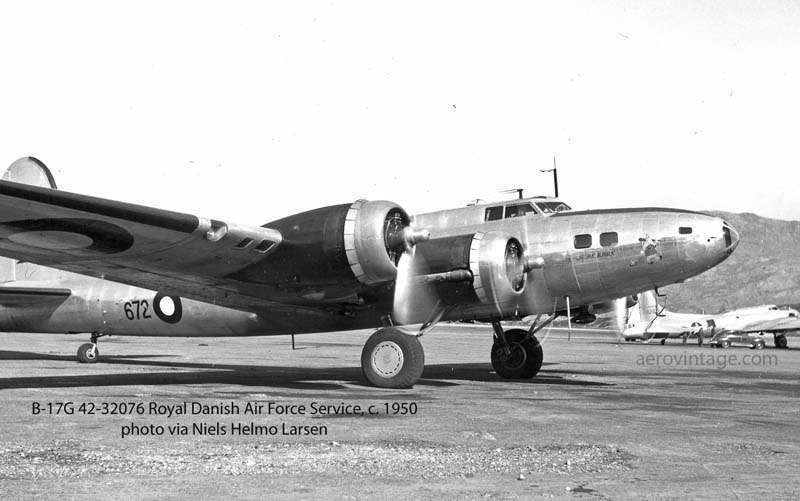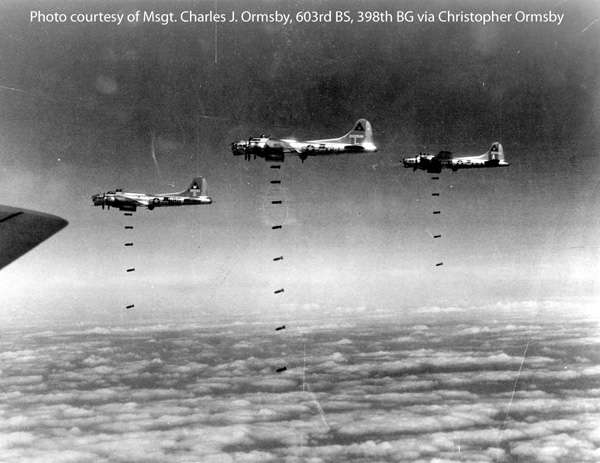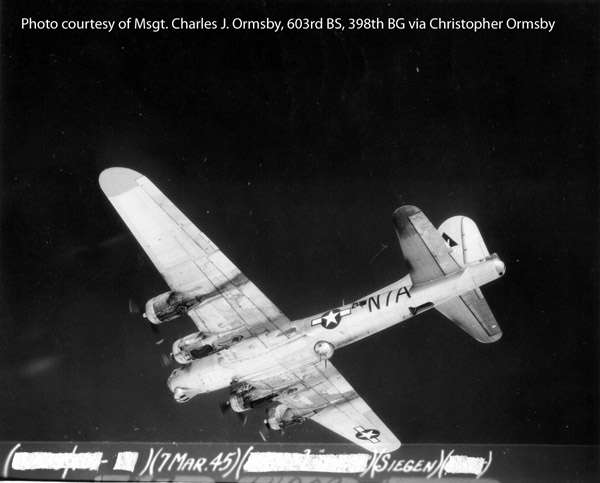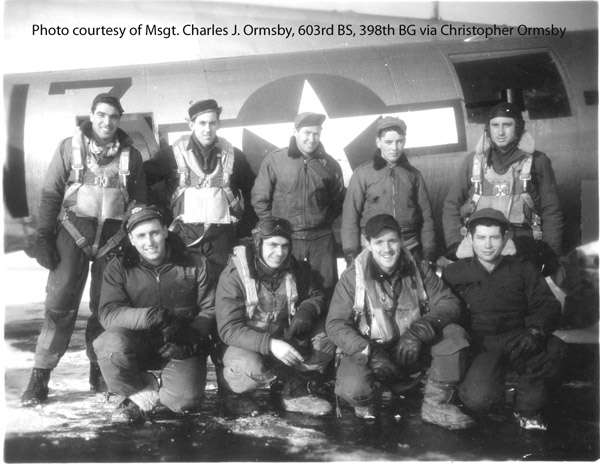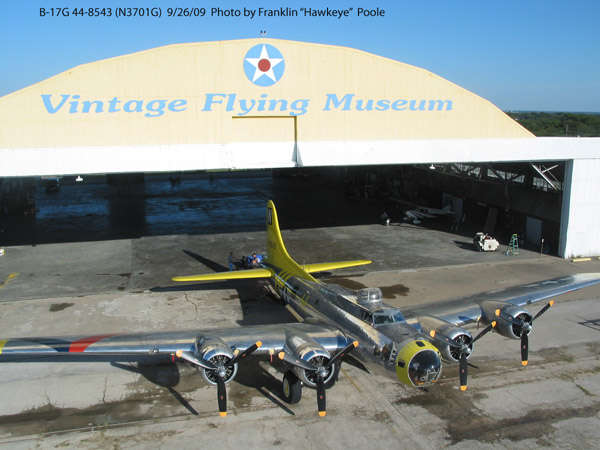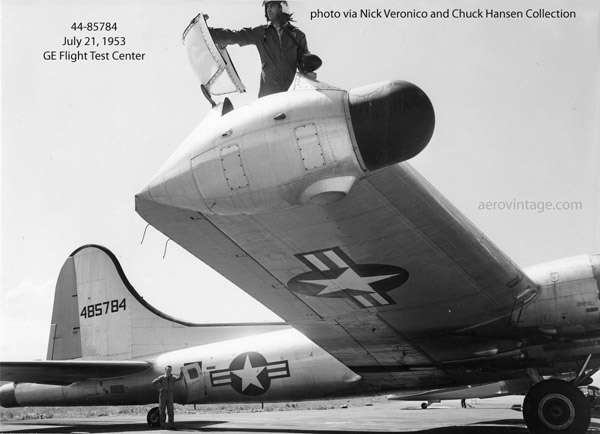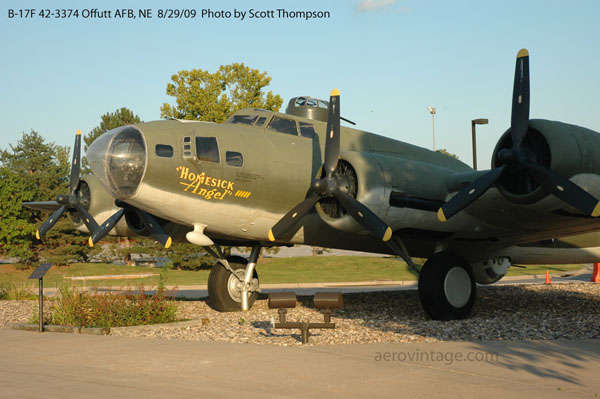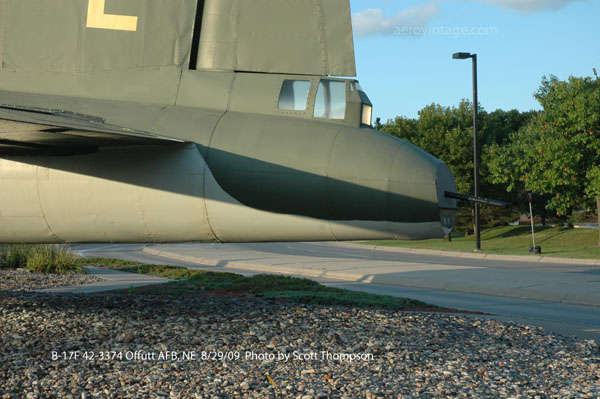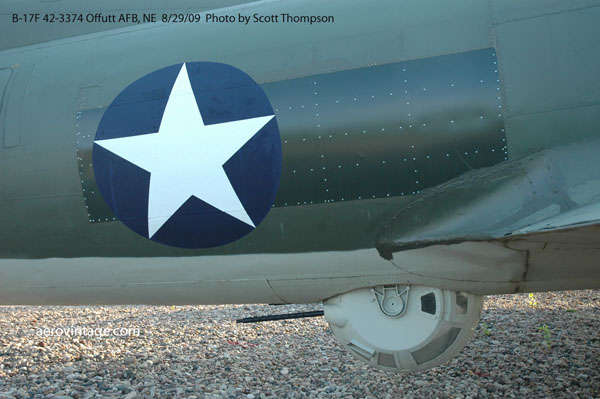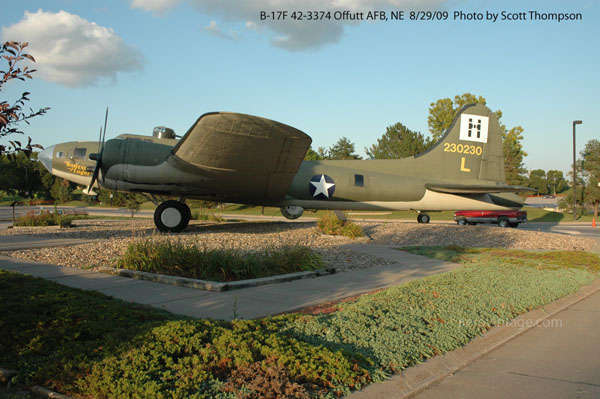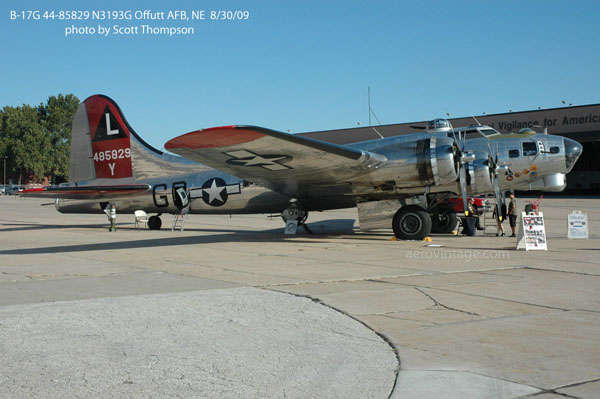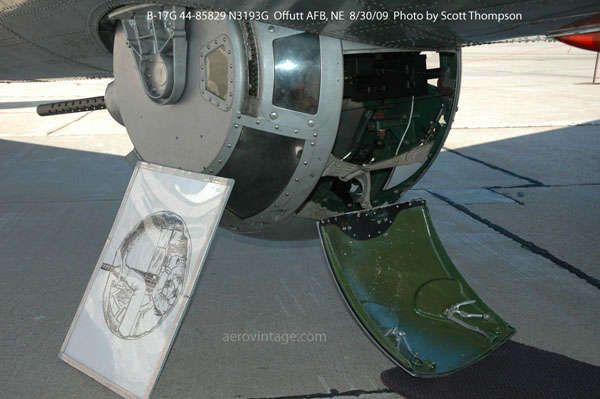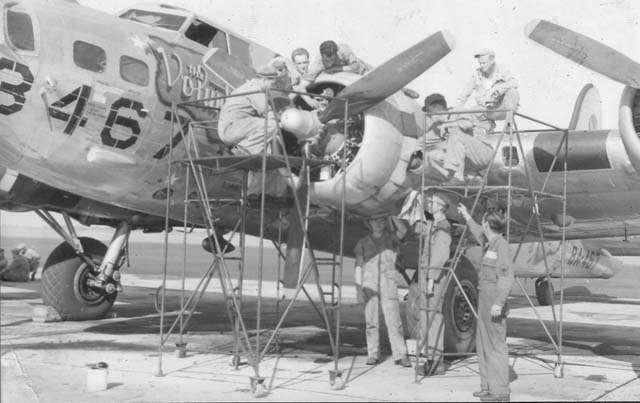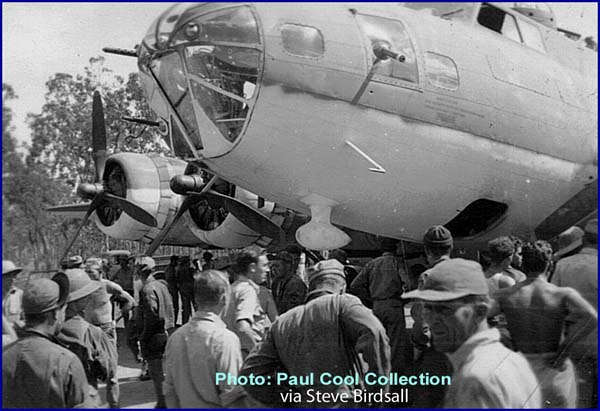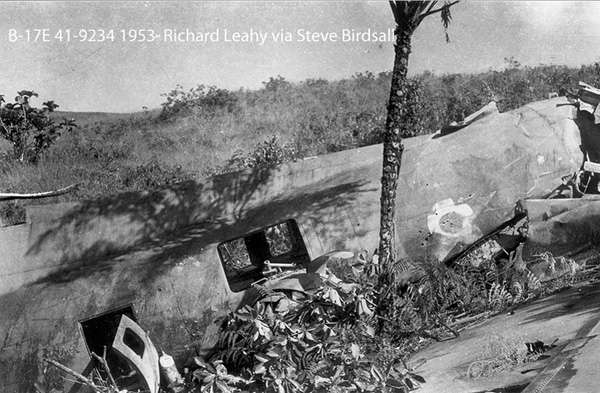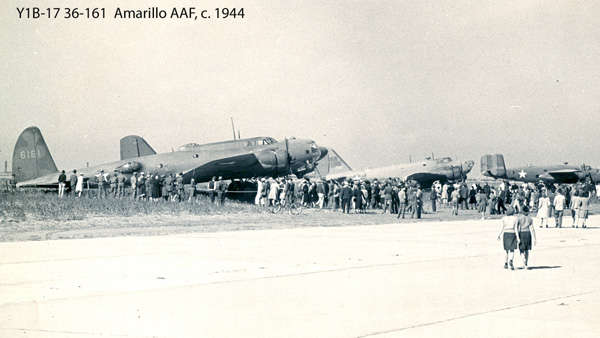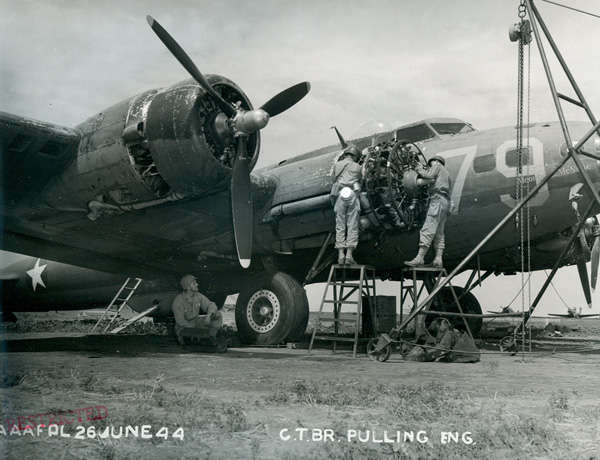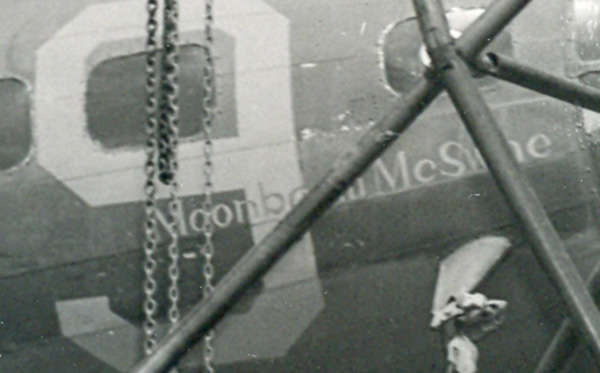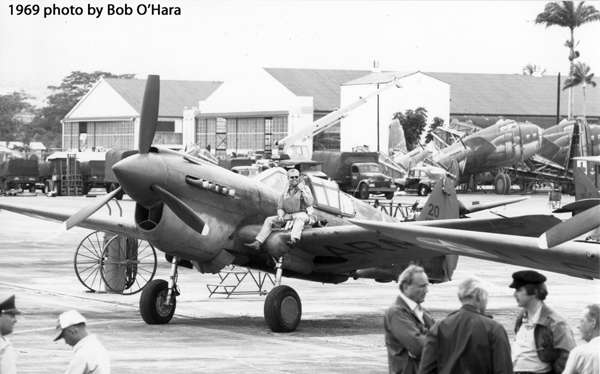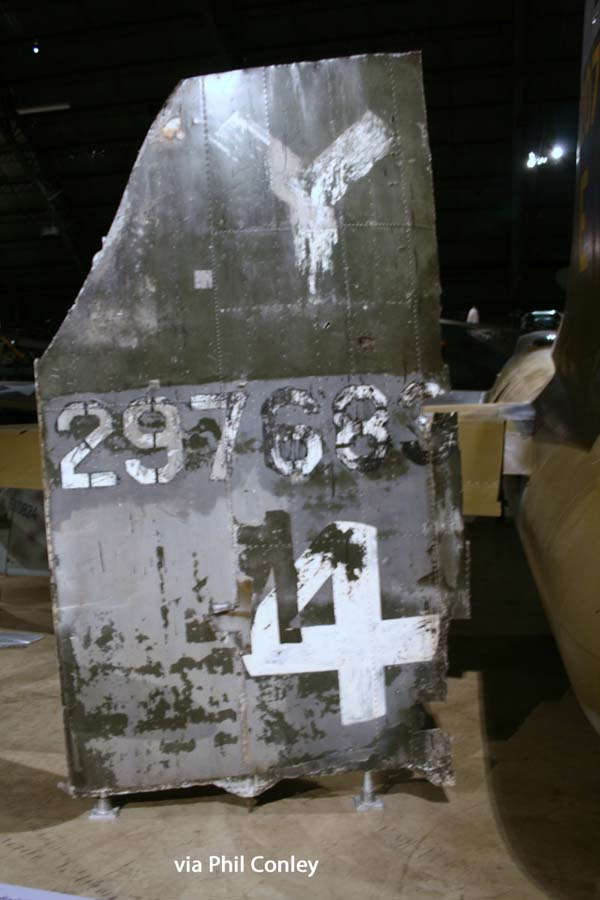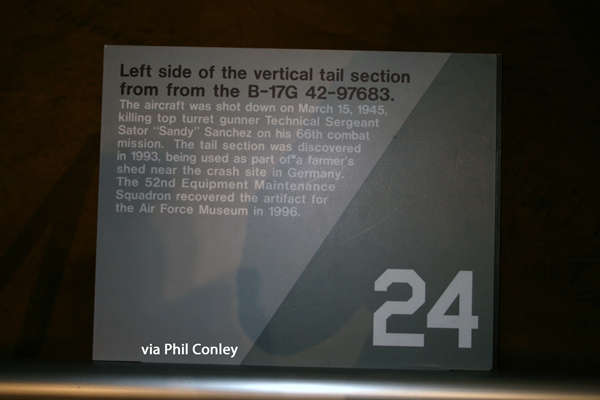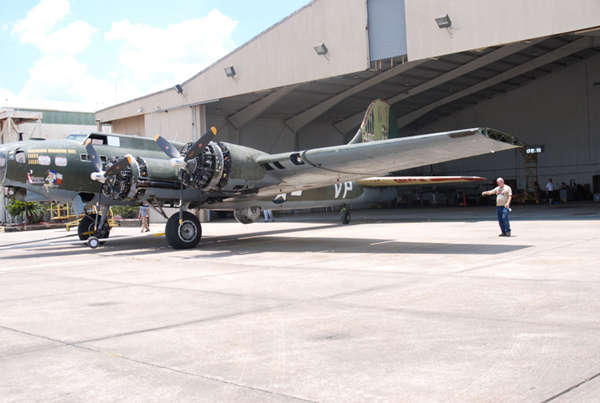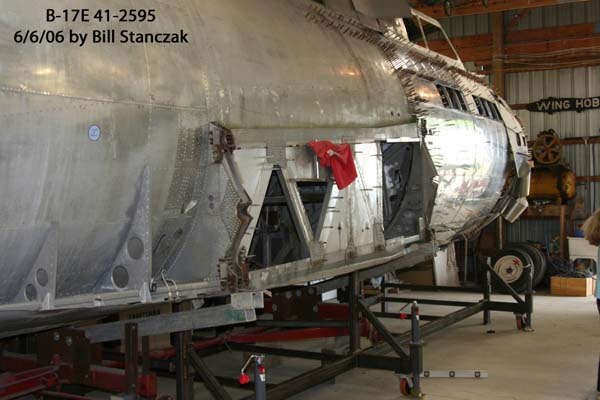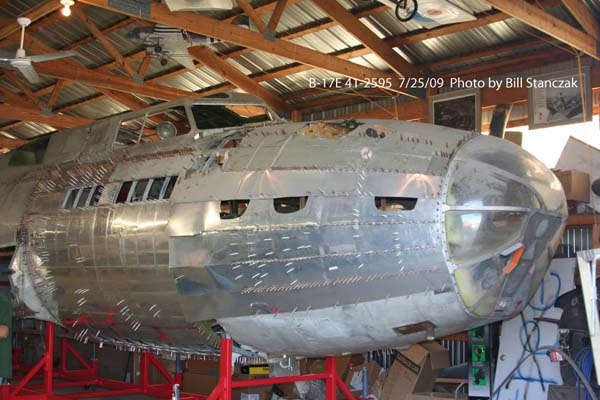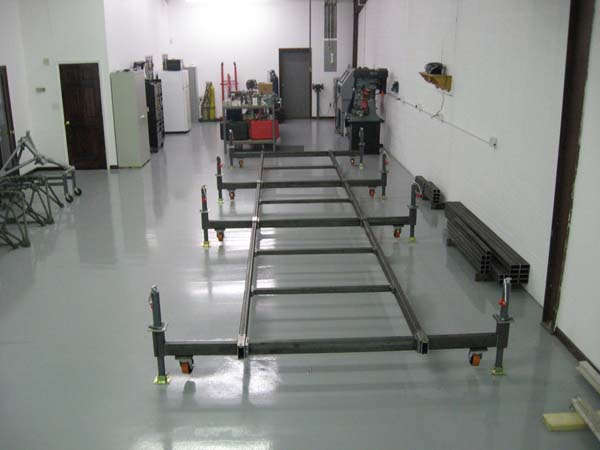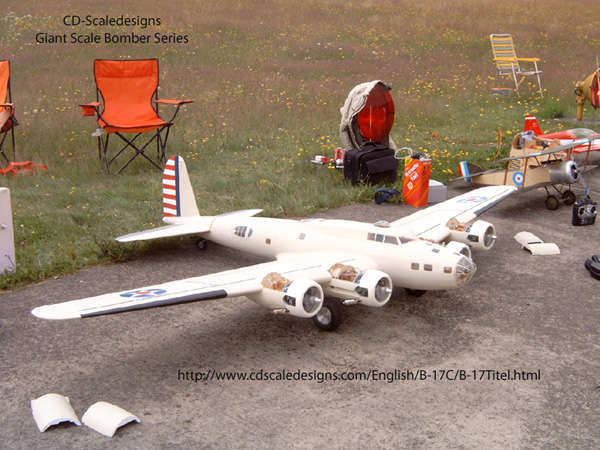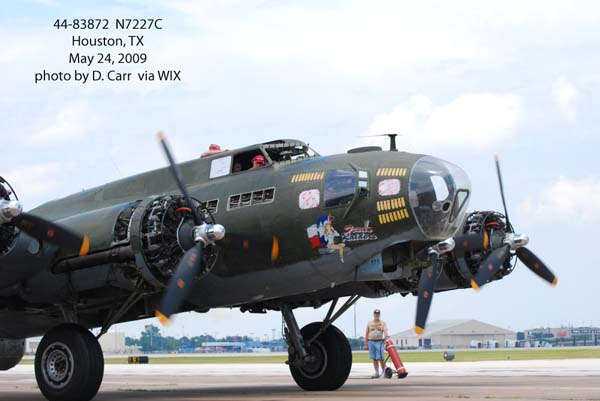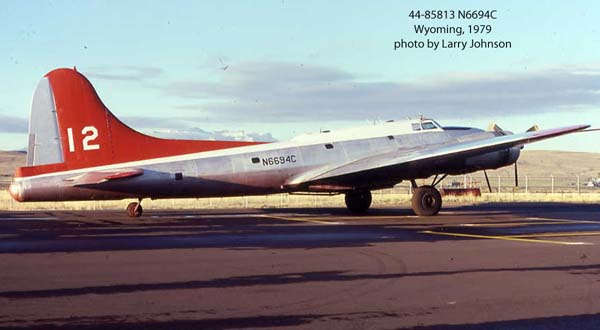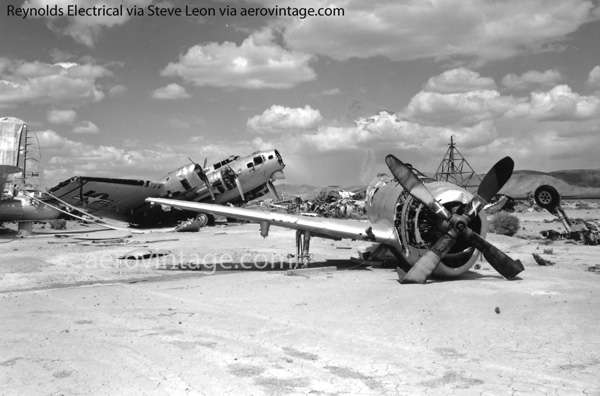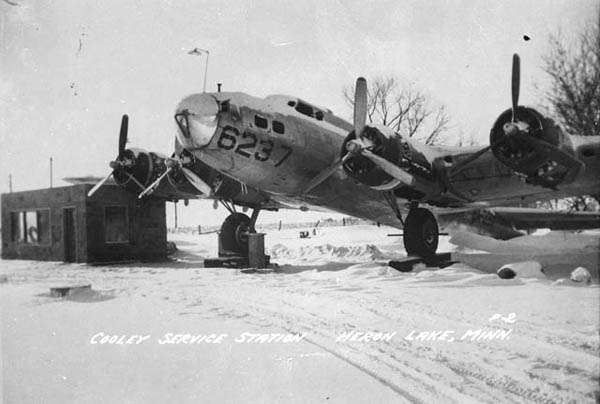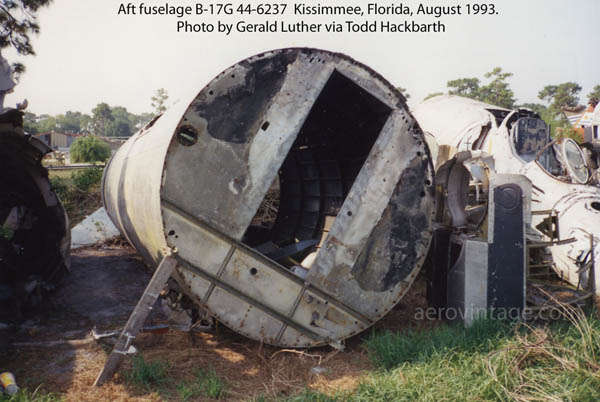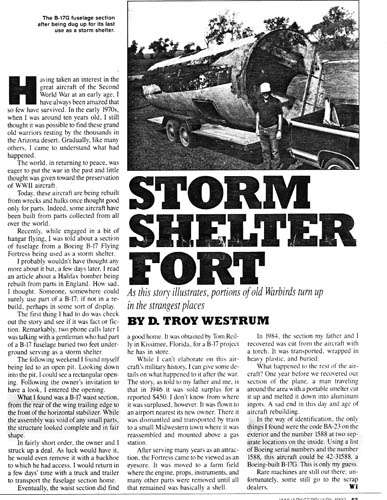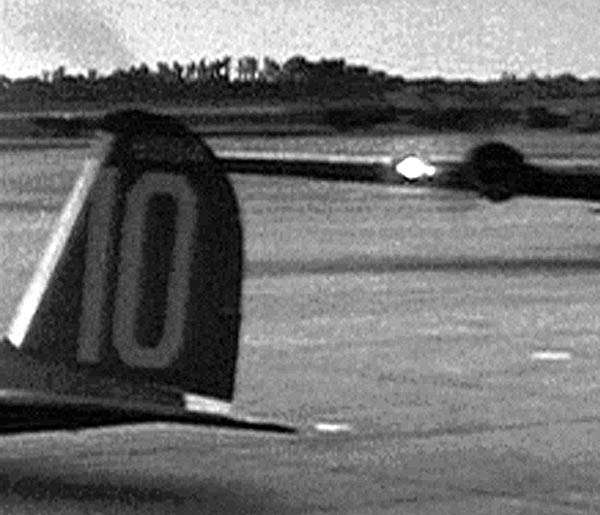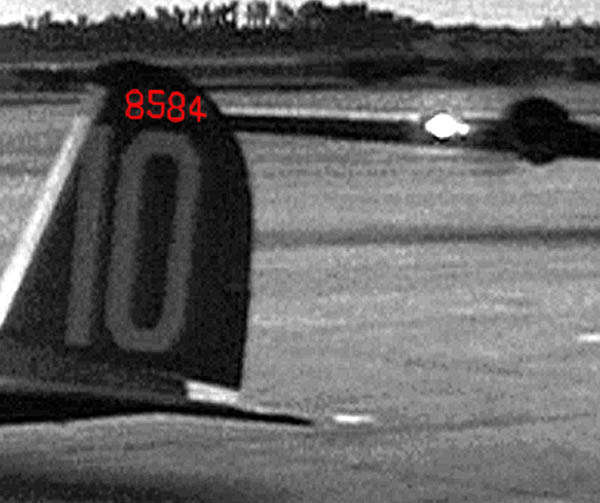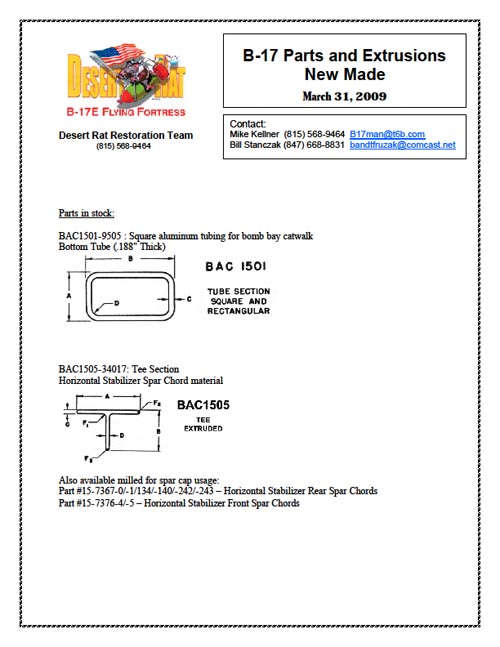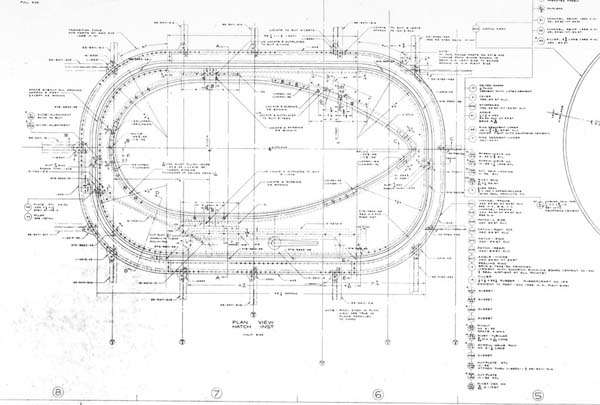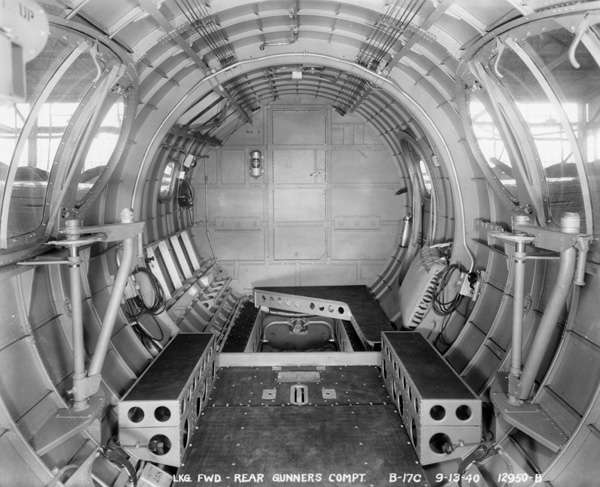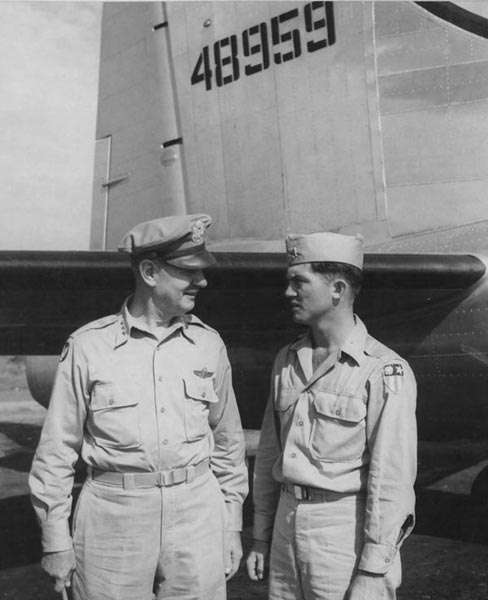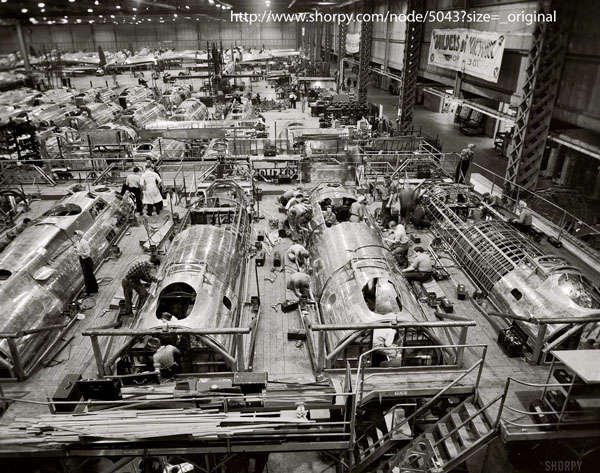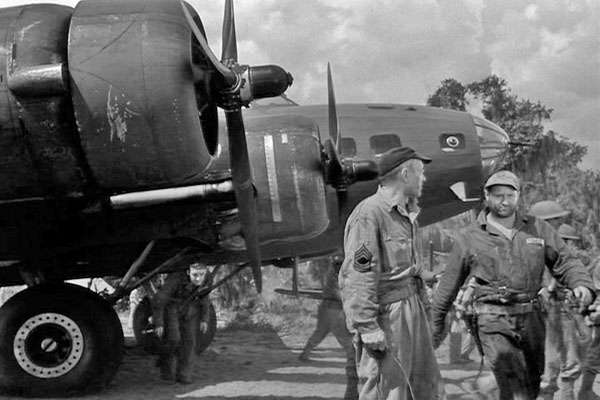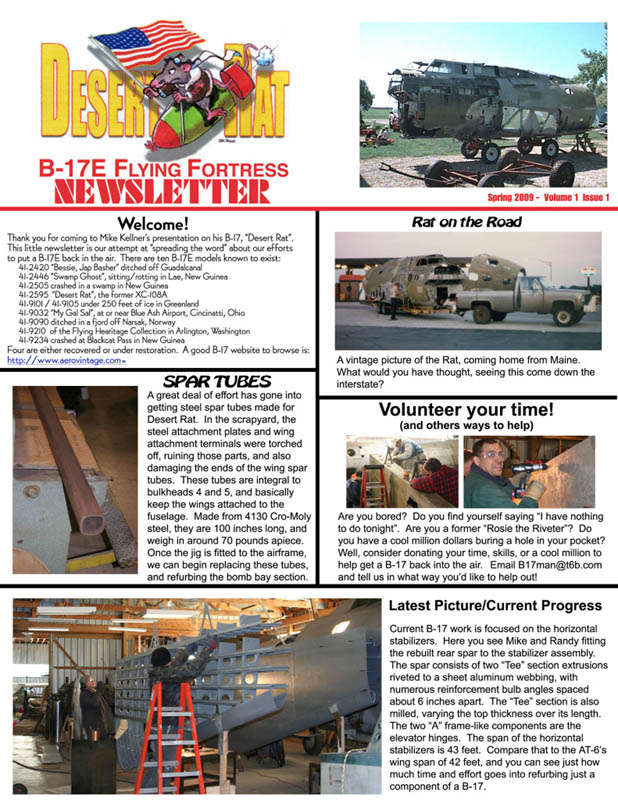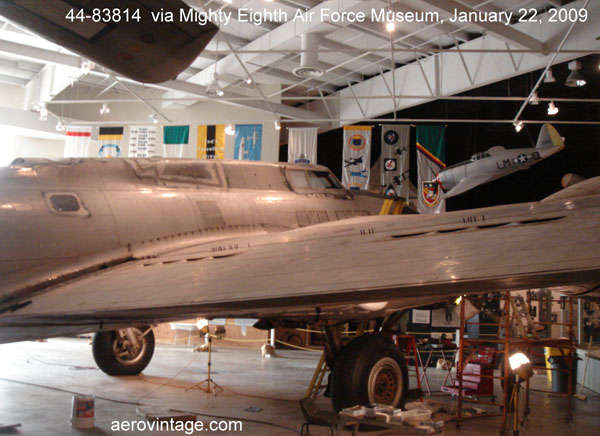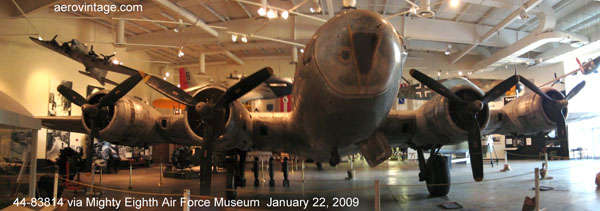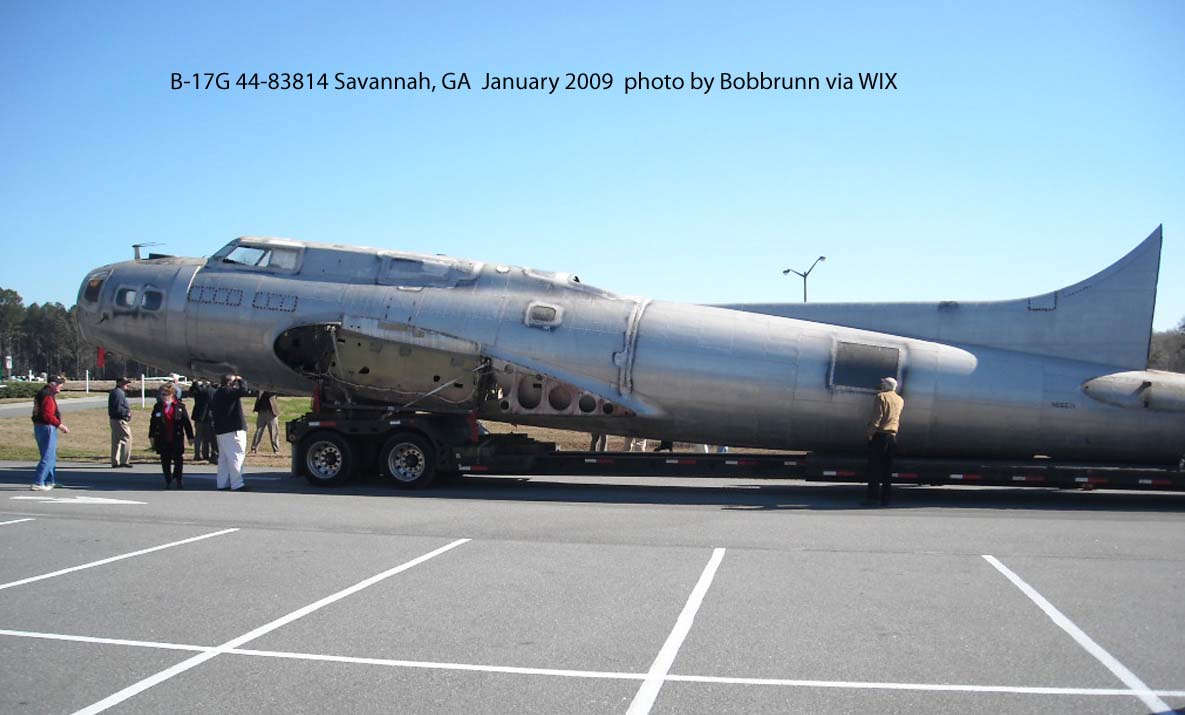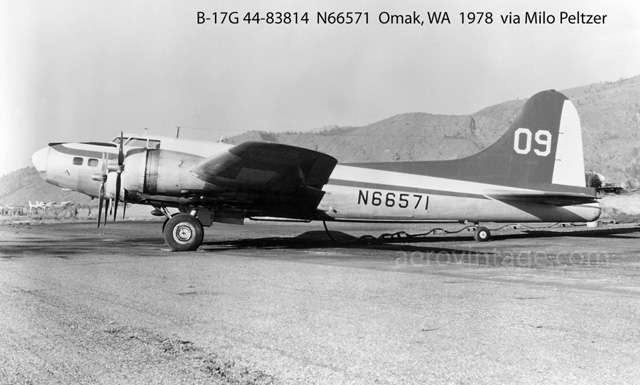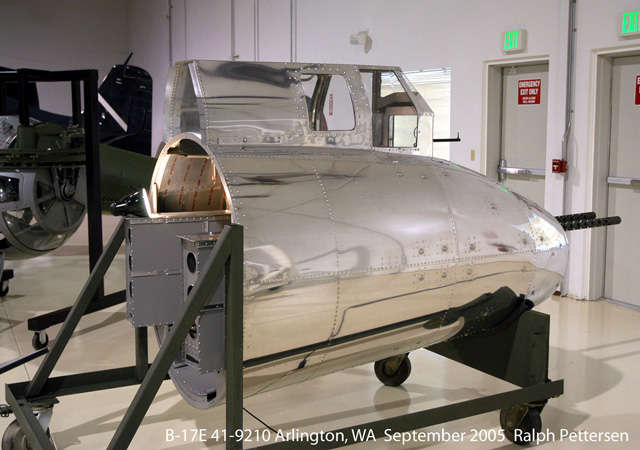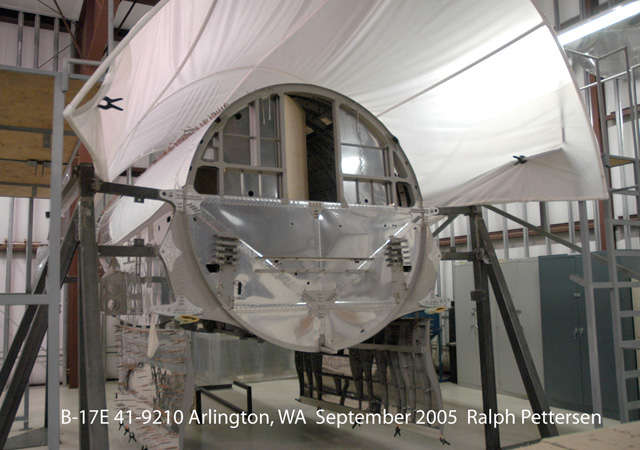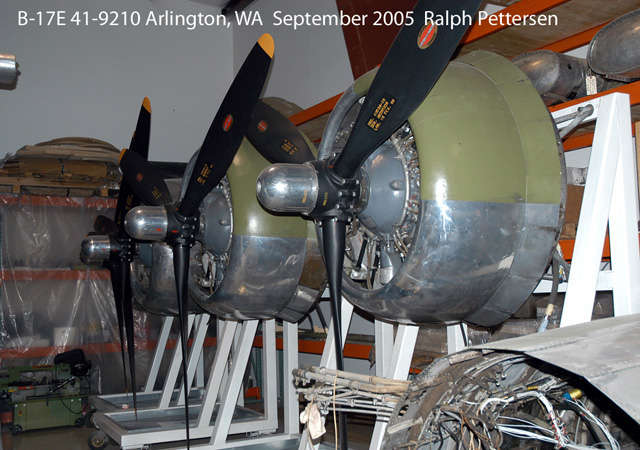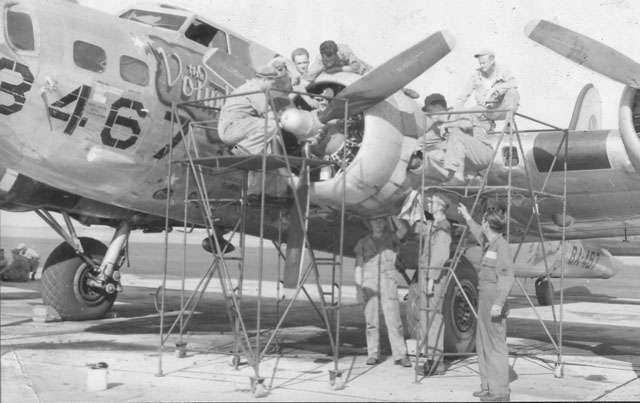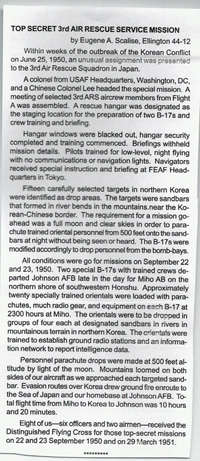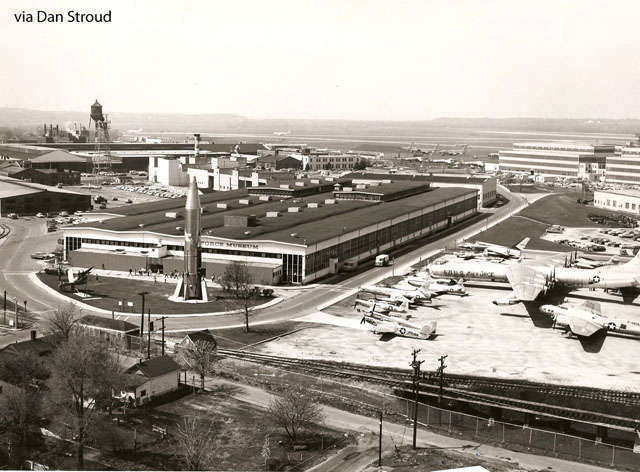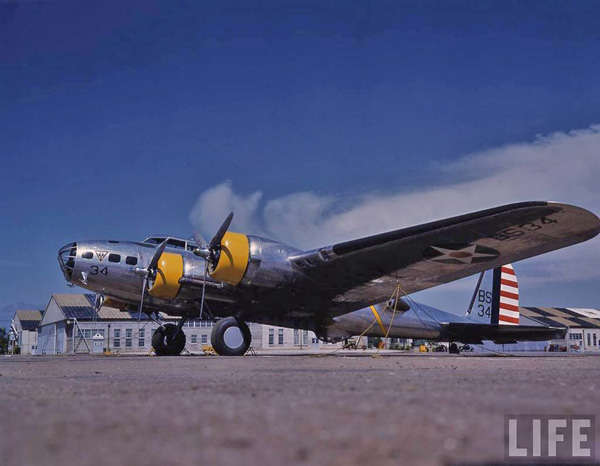
| site search by freefind | advanced |
AERO VINTAGE BOOKS
2009 B-17 NEWS
B-17 News Archive
2018 B-17 News
2017 B-17 News
2016 B-17 News
2015 B-17 News
2014 B-17 News
2013 B-17 News
2012 B-17 News
2011 B-17 News
2010 B-17 News
2009 B-17 News
2008 B-17 News
2007 B-17 News
2006 B-17 News
2005 B-17 News
2004 B-17 News
2003 B-17 News
2002 B-17 News
1997-2001 B-17 News
Back to the Main Page
We're including this page as an update point for B-17 news. We'll post information garnered from any variety of sources, and notate that source at the end of the item. If anyone has anything they'd like to add, please let us know.
December 2009 Addendum
- (added on 12/10) Hartmut Gohle from Denmark sent me some information that has left me red-faced and whirling around trying to find someone else to blame. He noted that my June update showing this fine photo of the Swedish airliner SE-BAO is actually not 42-97115 as I had originally captioned but rather 42-97155.
Well, my copy of Final Cut shows that 42-97115 is correct for SE-BAO, as do a number of other definitive sources. Well, guess again, bucko, because it would appear that Hartmut and several other definitive sources are absolutely correct: 42-97155 is the correct serial for SE-BAO. This is based on the Missing Air Crew Report (MACR) that definitively shows the latter airplane going to Sweden on April 11, 1944, with the crew subsequently interned by the Swedish authorities, and this ties up with other information about SE-BAO.
For all you folks keeping your copies of Final Cut accurate, make notation changes on pages 216, 218, and 221 (3rd edition) to show the correct serial number. It's easy to see how this error has crept into the lexicon but it is also frustrating to let errors like this be perpetuated. I've made more than a few such "perpetuating" errors, so I hate it even more when I make another. Bummer. But thanks to Hartmut for letting me know, and just what is wrong with all you other guys for not catching my mistake? It's all your fault!
Add another one to the pile for the 4th Edition.
December 2009
- To all who read this, a Merry Christmas to you and yours, and also a hope for some quiet moments away from avgas to consider the reason for the season. And it's not B-17s, nor widescreen TVs.
Okay, now sit a spell with some eggnog and catch up a bit.
- The file is getting thick, so here are a few items to close the year out. First off, Nick Veronico recently attended the Conference of Aviation Writers (CHAW) held in St. Louis, and ran into Dr. Randy McGuire of Saint Louis University (SLU). Dr. McGuire is the SLU archivist who curates the Parks College collection held by SLU.
Parks College was founded as an independent aviation school in 1927 and was named "Parks Air College." When its founder, Oliver Parks, couldn't find enough affordable space in Missouri to build his new campus, he found 113 acres across the Mississippi River from St. Louis, next door to the old Illinois village of Cahokia. He built his school there and during World War II, Parks became one of the first eight civilians to offer his services to the US government to train Army flyers. He also owned a second campus and airfield at Tuscaloosa, Alabama, which also became a training site for Army pilots. During the war he founded three more sites (Sikeston and Cape Girardeau, Missouri, and Jackson, Mississippi) and at these five Parks locations, over 15,000 Army Pilots passed their Primary flight training. After the war, Parks College was donated to SLU and it was eventually folded into the main SLU campus across the Mississippi River in Missouri.
Dr. McGuire had some interesting information, at least to me, about another of the RFC B-17s, this one used Parks College at the Cahokia, Illinois, training field between late 1946 and probably 1950 or so. This was news to me, so I happily add it to my list of RFC B-17s maintained here. This previously unidentified B-17G was Boeing-built 42-102829.
This B-17G was delivered from Boeing in April 1944, and served in a number of training units in Florida, particularly Drew Field, through the balance of the war (I would suspect the "D" on the top of the tail was a code for Drew, with the other code "W3" being the airplane number on the field.)
The record shows it released as surplus to the RFC in November 1945. Most of the other airplanes stored on RFC scrapyards were sold in field-size lots in a June 1946 auction and were subsequently scrapped (i.e. Kingman, AZ; Walnut Ridge, AR, etc.) but the airplanes as Altus were stored. Presumably, the Parks airplane was obtained in late 1946, early 1947, as part of the RFC disposal program for educational or memorial use. It was used at the college for technical training of mechanics and technicians. Where it went from Parks, and when, has not yet surfaced. There is no record showing this airplane ever being used for civil purposes, either in the U.S. or overseas. The RFC agreement normally specified that educational or memorial airplanes were to be scrapped or returned to the U.S. govt when the schools were done with them, and I would suspect the Parks airplane was scrapped on site after 1950 or so.
There appears to the be the name LES on the nose; no information on this.
There is more history about the airstrip at Parks College located at Paul Freeman's amazing Abandoned and Little-Known Airfields site.
- Head's up: When: August 7-8, 2010; Where: Willow Run Airport, Detroit, Michigan; What: Thunder Over Michigan; Why: Gathering of Fortresses. This be the 75th anniversary of the first flight of the Boeing Model 299 (July 28, 1935). Come one, come all B-17s and B-17-O-Philes. Underway: plans to find sponsors to help (fuel) to move up to a dozen B-17s up to 3,000 miles to get to and from the show. Let's see; 150 mph divided by 200 gallons per hour (.75 miles per gallon) divided into 3000 miles times 12 airplanes times $6.00 per gallon for 100LL....whoa, that's right about a $288,000 fuel bill. Not including oil... Gulp.
- Okay, I've been trying to get this update done for a week now. Gonna start throwing things up here (maybe no a good choice of a phrase) but here it comes, in no particular order. I had a chance to take a secret pre-tour of the new Lyons Air Museum at Orange County Airport in Santa Ana, California. Of notable interest here is the current state of Fuddy Duddy, also identified as 44-83563 (N9323Z). Just a peek.
- Okay, onto an up and coming B-17G. Shay Geeding made a visit to the Urbana restoration site on November 30 to see the progress of 44-85813, now known as the Champaign Lady, and posted some photos on the WIX forum. He was kind enough to let me use a few here. The airplane is making amazing progress, as is obvious from these photos.
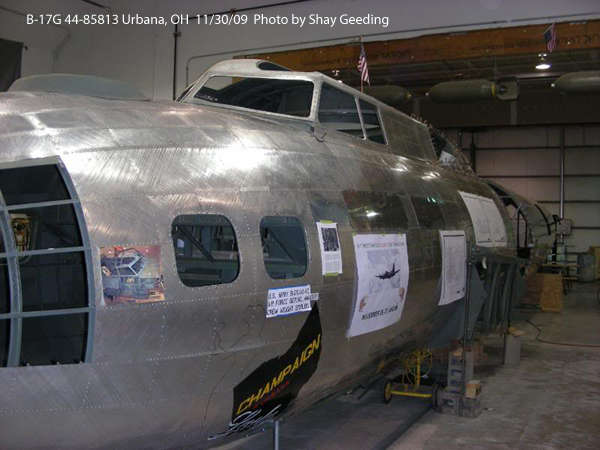
The left side of the forward fuselage, externally complete, with the beginnings of nose art being applied.
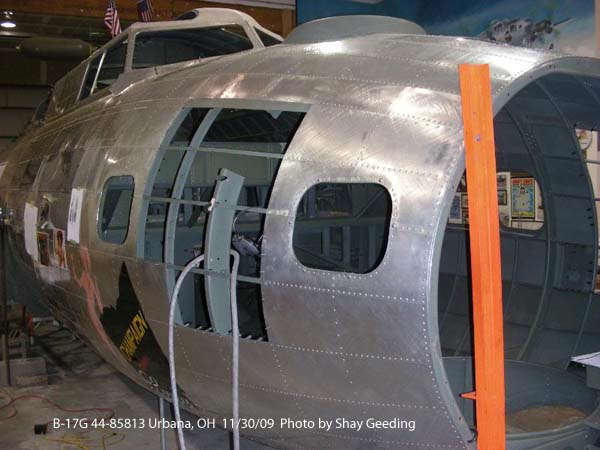
Right side with one of the forward windows waiting installation.
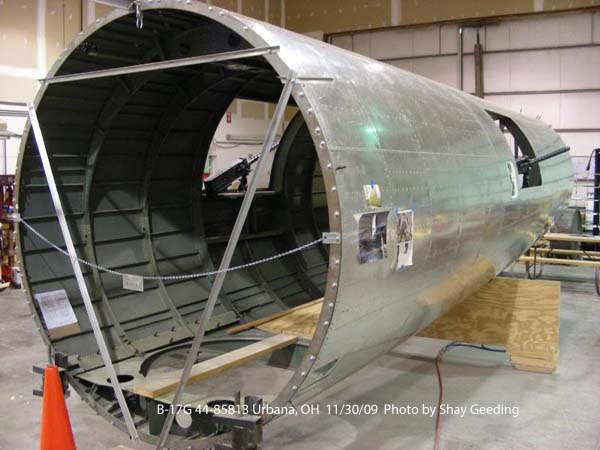
The aft fuselage from the aft end of the radio compartment (where it mounts to the bulkhead at Station 6) to the bulkhead at Station 8 (where the tail gun compartment will be added). One of the major challenges of this fuselage project is that there is not radio compartment available. Right now the fuselage stops at the aft bomb bay bulkhead (Station 5) and picks up again at the forward waist attach point (aft of bulkhead at Station 6, the fuselage production break). The radio compartment section will have to be hand built from the original plans. Harder than it sounds.
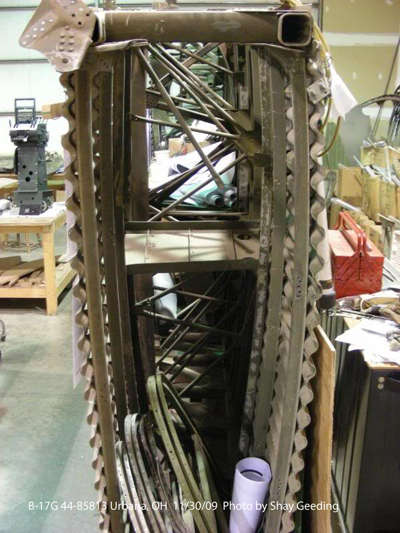
Part of the wing structure with work just getting underway.
One of thw WIX posters, Maverick, provided a concise and accurate source of the many parts coming together on this airframe, forever to be known as 44-85813, which I quote here in its entirety:
44-83316 was the donor for the aft fuselage from station 6 to station 11. Actually everything in this section was replaced with new parts except for the ball turret platform and bulkhead 7.
44-83722 is the donor for the bomb bay and flight deck part of the fuselage from station 5 to station 3. All of the skins, longitudinal stiffeners and most of the circumferential stiffeners were replaced. 722 was missing everything forward of station 3. Station 3 forward was built from plans with all new parts, except the chin turret ring. The outboard wing sections are also from 722.
44-85813 is the donor for the inboard wing sections, the data plate and FAA registration. Part of the fuselage section of 813 was used by Tom Reilly in the restoration of Liberty Bell and is not part of Champaign Lady restoration.
Otherwise it's a good recap of what the make up of Champaign Lady will be. Its fair to say that many other parts used in the restoration will come from other unknown donors. The stinger tail we have comes from Tom Wilson's shop. The radio room will be built next from plans. These will complete the fuselage.
It might be added also that the vertical stabilizer is one that once had the serial of 44-83525 applied. That airplane is with the Fantasy of Flight collection in Florida, and it has another vertical stabilizer attached (where did that one come from?).
- A bit further to the news in October that 44-83872 (N7227C), Texas Raiders, had flown again is part of a press release put out by the CAF to mark the occasion:
Seven years, nine months , nearly 120,000 man-hours and over $500,000 worth of heavy maintenance and restoration have finally resulted in success. On Wednesday, October 14, 2009, TEXAS RAIDERS, one of just a handful of flyable B-17s, took to the skies with the help of a hearty band of wing members, Houston Hobby Airport firemen, security personnel and a few surprised onlookers. The day’s forecast had called for some ugly afternoon rain showers, but the crew of this remarkable B-17 Flying Fortress found the skies to be more than accepting for this first flight after years of toil, repair and expense.
And, where would a press release be without a nice photo. Well, this one had one.
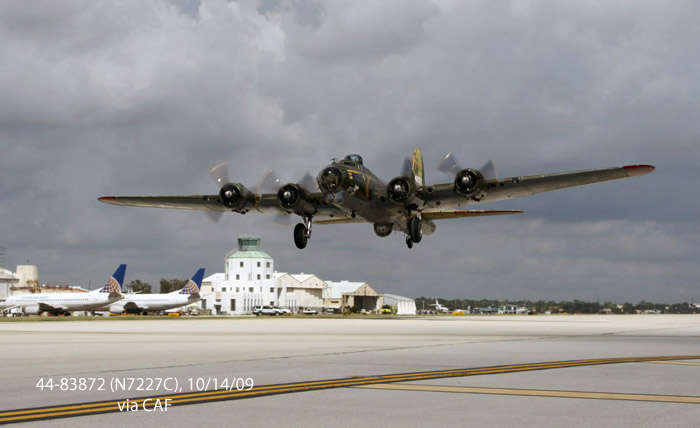
Pilots for the flight on October 14 were Al Maxwell and Rick Sharpe with Don Price along as observer. Once again, congrats to all.
- Al Doner sent in a few photos that I thought were of particular interest. Here is a bit different view of 44-8543, now flying as N3701G, aka Chuckie. This photo was taken in the 1950s during the airplanes stint, apparently, with the Federal Telecommunications Corp. Nothing particularly new to see in this view...just a view I have not seen before.
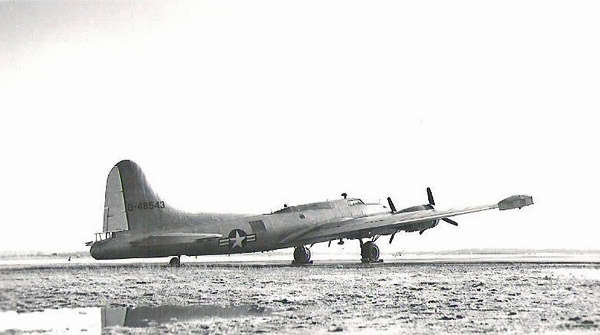
Or how about this view of an unidentified B-17G on a postwar or near postwar, presumably German, airfield, probably in the summer of 1945
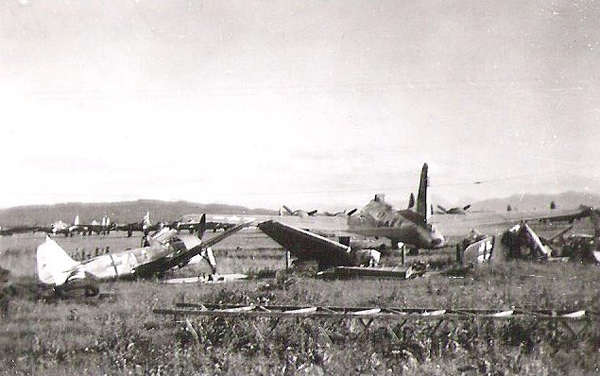
Or this trio of photos. In September 1945, a display of American (and Allied?) aircraft were set up under the Eiffel Tower in Paris, including all the major U.S. types. Here is a view of some of the airplanes, with a view of B-17 from the 96th Bomb Group:
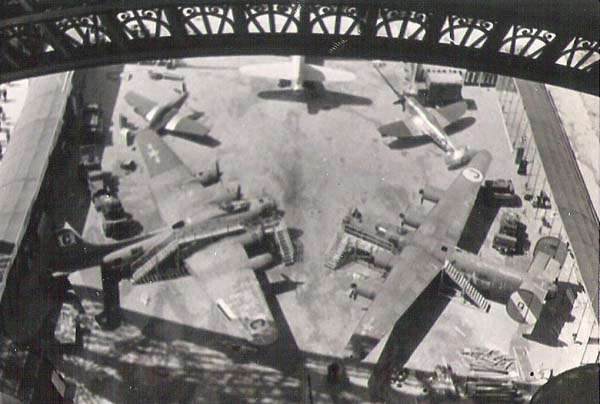
Another B-17, this one from the 94th Bomb Group.
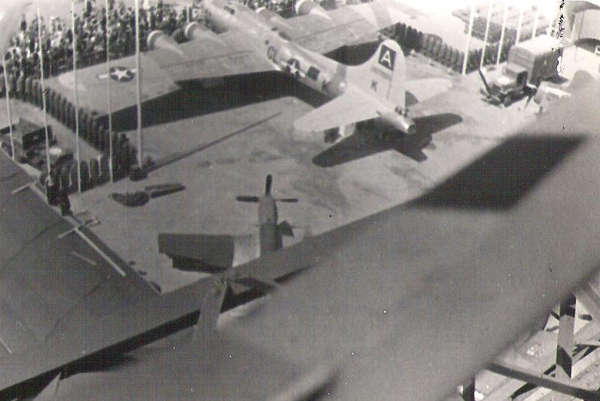
This is believed to be the above airplane, marked as Lucky Rebel, making this airplane B-17G 42-107180. Records show this airplane was salvaged in Europe three months later. Not sure why the airplane is up on the stand with the gear retracted. Good question.
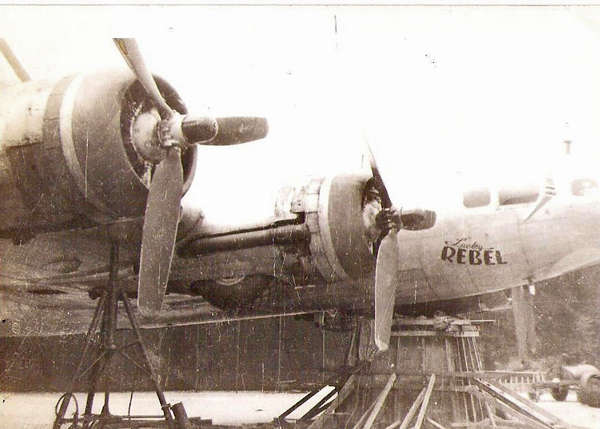
Thanks much to Alan for passing these photos along for me to use.
- Hot news!! Well, I was surfing the 'cool sites' on the net recently, I think it was the TMZ site, when I found this photo of Brad and Annie doing their Christmas shopping!! I was sure surprised!!

I heard the Brad had a thing for B-17s. I was skeptical but I guess it is true!! The whole family are true and devoted Aero Vintage fans!! A special day, indeed. If you want to be just like Brad and Annie, you can jump to the catalog page and order some books!! You buy them, you are guaranteed to be just like Brad and Annie!! Guaranteed!! (Unless you don't want to be, then you won't be, guaranteed!!)
- Forthcoming Movie with B-17 Content Number 1: Received information about the upcoming production of a family oriented film, with spiritual undertones, entitled The Last Mission honoring a fictional B-17 wartime crew drawing near to the end of their respective lives, and how they interact one last time. It apparently will or has used B-17G 44-83514 (N9323Z), Sentimental Journey for the production. I have no more details that what is on the website other than, as of June 2009, it will "begin filming soon." Check out the graphic link for more information.
- Forthcoming Movie with B-17 Content Number 2: Received information about the upcoming production of a new movie entitled War Birds: the promo material indicates that
"Birds" follows an Air Force veteran-turned-reckless airshow re-enactment pilot as he gets pulled into the underground culture of illegal, real-life aerial combat. Shooting is scheduled for the summer in Michigan using all real airplanes and aerial sequences, including authentic P-51 Mustangs, P-38 Lightnings, F4U Corsairs and a B-17 Flying Fortress as well as modern military helicopters and jets.
This one makes me a bit nervous, folks. If 'Birds (as the cool people apparently call it) ever gets to the widescreen, the general public will think all those P-51s and B-17s flying around have real guns and bombs. If you really want the straight scoop, jump here. And, no idea what B-17 might be used. Michigan? Yankee Lady??
- Ron Strong sent some photos on in, including this one showing the current state of B-17G 44-83863 on display at the airpark at Eglin AFB, Florida.
And this detail of the heraldry on the right side of the nose.
This ex-Navy PB-1W, ex-air tanker, is getting a bit rough after several decades of display near the Gulf coast. I'd complain and say they need to put the airplane inside somewhere, but haven't sent any donations to help build a facility so I think I won't say anything.
- I mentioned Chuckie, B-17G 44-8543 (N3701G) in one of the above posts. A few items of note about this airplane have surfaces. The first is, thanks to the efforts of Bill (CrewDawg) Gorin, two accident reports with photos have been obtained that pretty much confirm what many, at least me, thought. This airplane was a domestic bird during the war and never went overseas. Details of the two accidents, thanks to Bill for providing me with copies of the reports (thanks, Bill):
Accident #1: February 12, 1945 at Cuyahoga Cleveland Municipal Airport. The B-17 was attempting a takeoff and went off the icy runway, damaging the nose and aft fuselage, and the number 2 and 3 props. Notable: the chin turret area was damaged, confirming it had a chin turret at the time, and the "radar dome" was damaged, confirming it had a radar unit installed in place of the ball turret. Also of note: a photo in the report shows the airplane named Weather Guinea Pig. No one was injured, the airplane was repaired. At the time of this accident, the airplane was assigned to the Flight Section, Flight Test Branch of Engineering and Procurement Subcommand at Wright Field.
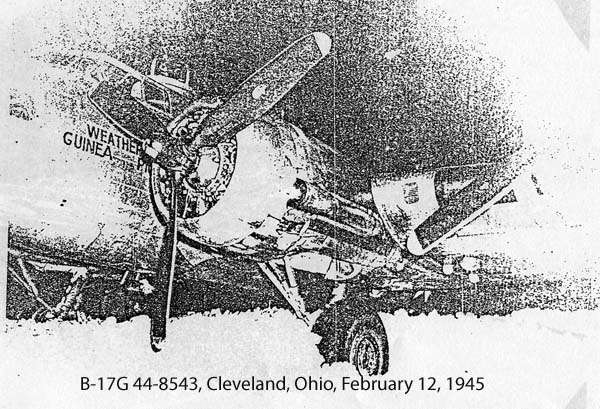
Accident #2: July 9, 1945 at Dayton AAF, Ohio. The B-17 was pulling out of a line of airplanes and turned too tight, hitting a P-47 prop with its left wing tip. The tip was damaged, the deicer boot was damaged, but the P-47 was fine (built tough). No injuries, airplane repaired. At the time of this accident, 44-8543 was assigned to the Flight Section, School Branch, of the ATSC at Dayton AAF. The photo reproduction is not good but it does show what appears to be the distinctive markings of the All Weather Test Center on the wings.
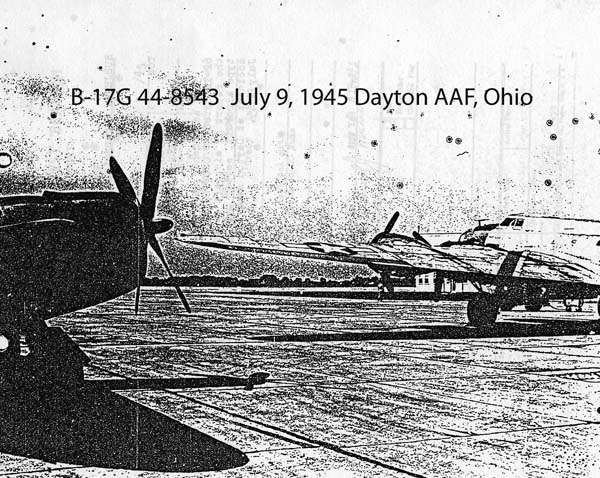
The main thing about all this is that the airplane was delivered by Vega in October 1944. The record for the early history is missing, but it was at Wright Field less than four months later, and remained there though the balance of the spring into the summer. It had a radar unit in the ball turret position being used to assist in weather research, and turned up later assigned to the All Weather Test Center when the AAF record card picks up. Pretty conclusive that this airplane did not go overseas to a combat unit as some sources previously suggested.
Also, Scott (Second Air Force) Horchstein added this in a recent post on the airplane:
Just a quick update on the PFF mods we're planning for Chuckie. With the help of a few wonderful researchers and warbird enthusiasts, I'm in the early stages of building the radome and radome support for '543. The plan is for me to build these components as "homework" in my shop and transport them down to Fort Worth for installation in the early spring. I'll be sure to post the progress when I get all the engineering done.
So, soon enough, the airplane will have a pathfinder radome installed in the ball turret position, an interesting and unique appearance for a 'warbird' B-17.
Finally, I had the chance to interact a bit with a crew representing Chuckie recently, including Chuckie Hospers, and had a very enjoyable time sharing things back and forth. Those guys are a dedicated bunch, including the ramrod behind the whole effort, Dr. Bill Hospers. They have suffered the good and bad of trying to operate a B-17 with a small, limited-funded group, and have well succeeded.
- Okay, I need to wrap this baby up or it will be next year before you can read it all. I'll stuff some of this stuff back in the file. But I do need to add one more little tidbit. I had the pleasure of communicating with a Niels Helmo Larsen of Kirkevangen, Denmark. We exchanged some DC-3 things, but he also offered some information and photos of some of the Danish B-17 operated in the late 1940s. There is a whole story there that needs to be fleshed out, but I just had to flash one of the photos out there as a sample. I hope to use some of these in an article soon enough.
Why, yes, I do believe that is B-17G 42-32076 in Royal Danish Air Force service in the 1948-1952 period. Location is unknown, but that a B-17G in the background has the USAF serial of 44-835X2; probably somewhere in northern Europe. The subject B-17 is, of course, the well-known Shoo Shoo Baby currently displayed at the NMUSAF. Cool. But there's more to come. I will post as I can.
- Well, that was a lot of stuff, but there you have the last update for 2009. Now, to close out the year, isn't there someone like your girlfriend or your air tanker pilot friend or your wife or your cubicle buddy or your boss or your Starbucks server or your postman or your B-17 veteran neighbor, someone who just popped into your mind, who really needs a last minute gift? I know just where you can go...... Seriously, though, don't spend too much money at Christmastime...that's not the point. Cherish your family and your friends and remember, quietly maybe, the reason for the season.
October Point Five 2009
- Too important not to mention: B-17G 44-83872 (N7227C) of the Gulf Coast Wing, CAF, took to the air today, October 14, 2009, for the first time in seven, count 'em, seven years. The airplane went down for maintenance in 2002 for the FAA Airworthiness Directive and one thing led to another. Major maintenance later, it is back up and flying. Scorecard: that would make thirteen flyers, boys.
From Don Price (shamelessly copied):
TEXAS RAIDERS flew for the first time in seven years today.
Fitting that it was Oct. 14th.
10/14/43 was Black Thursday.
My Dad bailed out of a B17 on that day over England coming back from the Scweinfurt Raid.Needless to say, we are a bunch of happy people down here and I am as proud of the Gulf Coast Wing as I can be.
On the second flight there was a sqwuak over a rudder shimmy so the crew went to Ellington, the closest airfield. The crew and the plane are fine. The maintenance folks are addressing the issue.
More as it develops.
Congratulations to a lot of people who did a lot of hard work and paid a lot of money to get this airplane back into the air. But, there was no one around to admire it with me and, even if there was, they probably would have just been polite anyways. So, I implemented Storage Plan A, which was to attach the elevator to the horizontal, store it from my little hanging shelf attached to the garage ceiling, and then store the rudder and vertical stabilizer stacked carefully above that. I thought about that for a few minutes and thought about just how many ways of something going wrong with that plan.
October 2009
- Sad to hear about the passing of actor Paul Burke on September 13 at Palm Springs, California, from leukemia and non-Hodgkins lymphoma. He was 83 at the time of his death. Paul Burke is better known to B-17 guys as Lt. Col. Joe Gallagher, valiant commander of the vaunted 918th Bomb Group for the latter half of the TV series 12 O'Clock High. I suspect his years on the series, 1964 to 1967, were among his career highlights, which I guess could be considered kind of sad. He was a pretty good actor and, from several sources, a pretty good guy too, for those who had the opportunity to meet him. He welcomed discussions about the TV series.
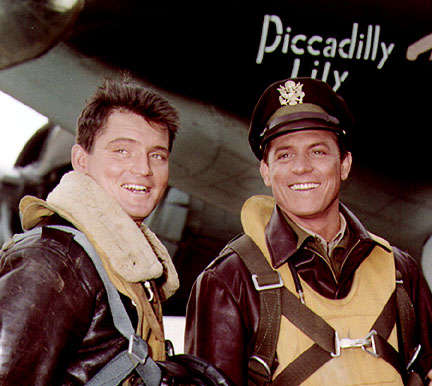
Here he is with actor Chris Robinson who played Sgt. Sandy Komansky on the series. Paul Burke's career spanned forty years, from 1951 to 1990. Here is more information at the Internet Movie Database. And here is a link to the 12 O'Clock High TV Series page right here at Aero Vintage Books. Check it out; I dare you.
- Every once in awhile I get some interesting photos that need to be posted. Christopher Ornsby sent in a few that came from his dad's collection. His dad, Charles Ornsby, was a flight engineer/top turret gunner on B-17s, evidently with the 602nd Bomb Squadron, 398th Bomb Group, flying from Nuthhampsted with the 8th Air Force in the UK in 1944 or 1945. Ornsby twin brother, George Ornsby, was also a flight engineer/top turret gunner assigned to B-17s with the 8th Air Force.
All three photos are interesting if only for the subtle drama that was captured live. At least the first photo has been out there within the group histories for awhile:
Here is some information about this photo that fills in some holes.
Here is another interesting photo showing an unidentified 603rd Bomb Squadron B-17 seen from below on March 7, 1945.
And, finally a crew photo:
- Alan Doner sent in this photo of B-17 44-85507 (N5116N) while operated by the Chicago Tribune as the transport for owner Robert McComrick in the early 1950s. This airplane went to the Mark Hurd Aerial Survey Co. in 1952 and crashed in Nevada shortly afterwards.
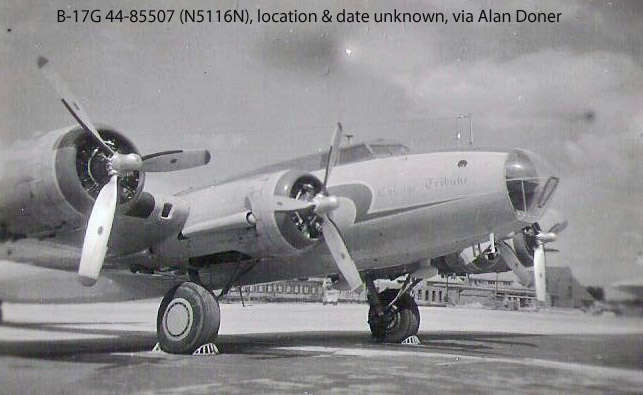
- Franklin "Hawkeye" Poole sent in this distinctive photo of Chuckie, otherwise known as 44-8543 (N3701G) taken recently after being preened for the annual Vintage Flying Museum hangar dance at Meacham Field near Ft. Wroth, Texas.
Great photo taken from an unusual angle. As an interesting aside was this photo posted on the Aero Vintage Forum showing the ball turret patch on Chuckie with the mention that the patch holds the remains of the skin adaptation for a H2X Mickey radar unit for this "Pathfinder" modified B-17G. The mounted radar had a smaller diameter than the ball turret, thus the patch in the patch modification.
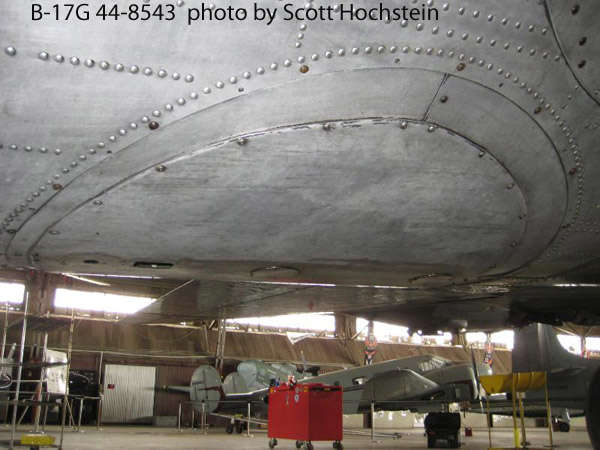
The AAF history of this airplane remains murky: it appears that it was never outside the U.S. during the war but was nonetheless modified to carry the radar. Someday we shall know more, or so we hope.
- I would be sorely remiss if I did not mention the article in the October 2009 issue of FlyPast magazine that covers a bit of the history of B-17G 44-85784 (G-BEDF), better known as Sally B. The article by Herr Webmaster covers the airplane in USAF service when it was assigned to the GE Flight Test Center for the development of a new radar unit. At that time the B-17 had some unusual wing tip pods.
This led to an interesting email exchange with Lars Kambeck of Hanover, Germany, who tells me of a wartime German aircraft designer named Richard Vogt who did pioneering work for the Luftwaffe for the Blohm & Voss Aircraft, and in particular its P163 design. Though never built, the P163 featured wing tip cockpits. Part of the reason for the unusual arrangement, as per an interview with Vogt, was that the Germans were trying to figure out how to use more steel in airplane construction as aluminum was getting harder to procure as the war went along. Apparently the structure needed for the wing tip pods lent itself to using steel. There were other advantages, one of which was the reduction of wake turbulence from the wing tips and its associated drag; kind of like a precursor of winglets. The interesting thing is that Vogt went to Wright-Patterson AFB after the war and continued his research in different areas. It seems but a short step to think that the unusual wing-tip pods on 44-85784 are associated with Vogt's work for the USAF>
- Got a chance to take a close look at B-17F 42-3374 that serves at a gate guardian at Offutt AFB near Omaha, Nebraska. The outside of the airplane looks pretty good, all things considered. There have been some effort to do some deeper maintenance on the airplane to address some corrosion issues, but it would appear time and budget constraints have slowed that work. The control surfaces have been metalled over but overall the airplane is externally complete and remains a tribute at the base that used to be the headquarters of the USAF Strategic Air Command.
And here is the tail gun compartment.
And here is some of the work done on the right fuselage waist area.
And, okay, one more, a side view:
You can go back through the pages of B-17 News and find a fair amount about this airplane, beginning with its film use with MGM and on to Planes of Fame at Chino and on to Beale AFB, California, before going to Offutt. Check it out; I dare your.
- While at the Offutt AFB air show in August, I also ran into Yankee Lady, otherwise known as 44-85829 (N3193G), and the Yankee Air Force crew. It was good to run into Todd Hackbarth and meet some other guys who make that airplane happen. Here a two photos of the airplane at the show.
And here's a photo of the ball turret, opened for a chosen few who are lithe enough to wiggle their way into the thing. Todd sat next to turret for quite a while explaining its workings and answering questions about the ball turret.
- Another photo has emerged of what is probably B-17G 44-83467. Readers of these pages can go way, way, back to February 2009 when this photo was posted:
Phillip Mallouk sent in a photo of the same airplane with his uncle as, apparently, part of the crew:
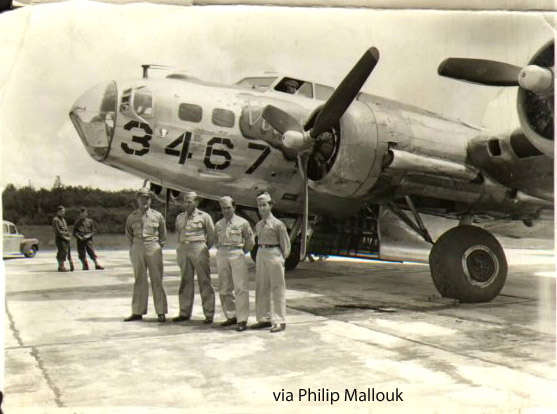
He passes along the following information:
I was researching a photo of my Uncle, George Keyloun who has just passed away a few weeks ago at the age of 85, and I came upon your very interesting and informative pages. It was very hard to find any information on the particular aircraft my uncle flew. He told me he was a radio officer and flew on all of the big planes of WWII.
Here is a photo that could shed some light and supplement the photo you have on your page. Clearly the aircraft is numbered 3467 and the paint job and name appear to bear this out. Here is a photo for your reference. My uncle George is the officer on the right, with the black belt.
Thanks to Phillip for the different view of what appears to be an early postwar B-17.
August 2009
- Some interesting stuff going back and forth at the Aero Vintage Forum concerning B-17E 41-9234, the long abandoned Fortress that crashed at Black Pass Pass in New Guinea in January 1943 after a bombing raid with the 43rd Bomb Group. So the airplane has been laying on the side of a mountain for sixty-seven years. Here's a 1990s(?) view of the airplane:
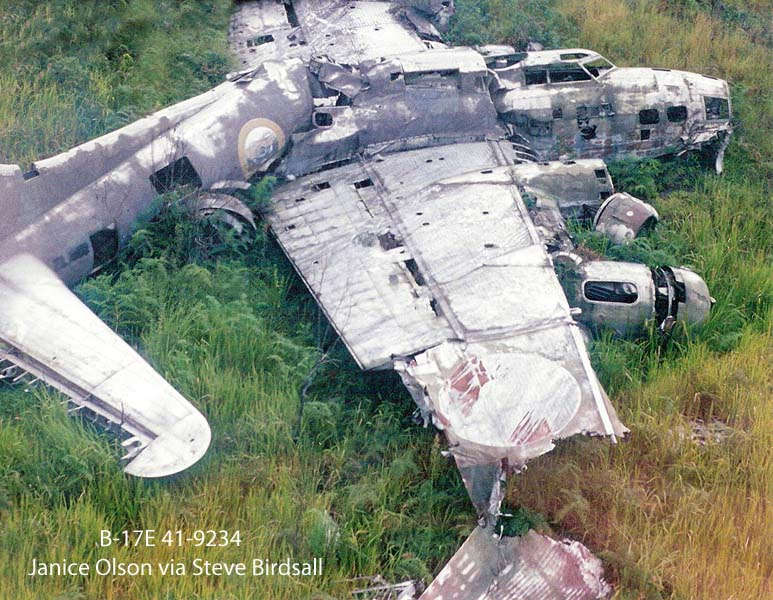
For many years, there was a bit of mystery about why this B-17 was marked in RAF colors, as the RAF operated no B-17s in the Pacific War, particularly in 1942 or 1943. As can seen above, the airplane retains the remnants of an RAF paint scheme, roundels, and the apparent RAF serial. Steve Birdsall has done much research on some of the early Pacific B-17s, and he passed along a bit of history of this B-17E and some details of it's unusual paint scheme and a significant combat mission:
"41-9234 had originally been destined for Britain , and she was one of 32 Lend-Lease B-17Es delivered to Cheyenne , Wyoming between the middle of May and very early June, 1942. These aircraft carried Royal Air Force markings and serial numbers, but retained their original Army Air Forces radio call numbers on their tails until they arrived in England , where these were simply painted over. Four of these aircraft - 41-9196, 41-9234, 41-9235 and 41-9244 - did not leave for Britain , but instead were flown to Hamilton Field during the first week of August, proceeded on to Hawaii and down to the Southwest Pacific, where they joined the 19th Bomb Group in Australia. On 26 August 1942 41-9234 was one of the force of eight B-17s which made a low level attack on a Japanese convoy at Milne Bay on the south-eastern tip of New Guinea . Lt. Jim Dieffenderfer, flying as co-pilot for Captain John Chiles on 41-9234 that day, recalls, "We were supposed to assemble in an eight ship formation but due to darkness and weather never made it. When we got an airplane on each wing we headed for Milne Bay and got there in daylight . . Captain Clyde Webb was on our left wing . . ."
Flying by dead reckoning, they let down through the gloom and found the convoy below them. With the ceiling down around 2,000 feet the B-17s were given a murderous reception. Dieffenderfer says, "Just before bomb drop we saw Webb get a direct hit in #2 engine - he went over on his back and into the water, no sign of parachutes". Webb's B-17, 41-24354, left a slick of orange fire which burned for ten minutes, and Chiles was also in trouble in 41-9234. Sergeant Wathen Cody, the flight engineer, recalled, "We, the three of our B-17s got into firing range on our bomb run, all anti-aircraft guns on the shore and ships cut loose. The B-17 on our left got its left wing blown off and it went down, our plane was getting hit. Our bombardier, Sgt Earl Snyder, salvoed the bombs. Captain Chiles called the bombardier and no answer. So I went down to check. [Navigator] Lt David Hirsch was bleeding badly all over, his face speckled with Plexiglas from the nose, big hole. His leg looked like it was blown off. Grabbed the first aid kit and Hirsch said take care of Snyder he's hurt worse than I am. Snyder was laying over the bomb sight with his hand on the bomb release handle, and when I got over him I could see a piece of jagged metal in his head, size about three inches around and about two inches deep in his head. So I went back to Hirsch and tied a tourniquet around his leg so he wouldn't bleed to death. Picked metal out of his face and arms. Then I pulled him up in the cockpit with us and laid him beside my turret. About this time we were attacked by Zeros, we got in the clouds and got home, but our plane was all shot up."
Safely back at Mareeba, all of the crew except Snyder had survived what Cody calls, "Our crew's first real bombing mission". As he walked away after returning, Cody remembers that the ground crews were counting the holes in 41-9234 and that, "This plane was painted white on the bottom and light blue on top . . . blood ran out of the holes and the front of the plane was a terrible looking mess".
What Wathen Cody remembers as light blue and white was confirmed by Robert Stitt, (who visited and photographed the wreck in 1977), to be the British "Temperate Sea" camouflage scheme - a disruptive pattern of Extra Dark Sea Grey and Dark Slate Grey on top and Sky undersurfaces.
Steve came up with this photo of 41-9234 and positively identified it by using a high resolution scan and pulling the serial off the data block:
Steve thinks this photo shows the aftermath of that August 26th raid. Note the several holes in the nose section, and in particular the one on the corner of the large nose window corner. Before he did the high resolution scan, Steve thought he already had a match based on the crashed aircraft's repair to the same corner of the nose window.
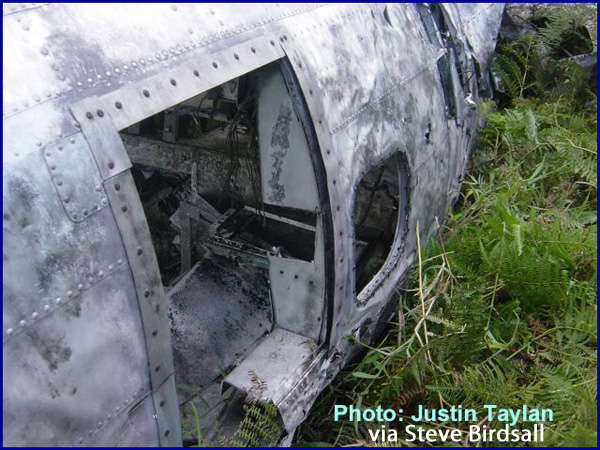
Steve also sent along a photo of this airplane taken in 1953 by Richard Leahy. Very interesting to see how the airplane looked just eleven years after the crash.
Steve notes:
Here's one of the earliest postwar photos of the wreck, taken by Richard Leahy in 1953. There's a lot more of the aircraft's equipment still there. The AAF star has almost completely faded away to reveal the RAF roundel, but the RAF serial, FL461, has not yet been revealed aft of the fuselage door.
Interesting stuff, as far as I'm concerned. That B-17E, for good or bad, is still out there on the side of the mountain. But the story of the RAF B-17 in the early Pacific war is a bit more explained.
- Speaking of old B-17s, Scott Hochstein has been digging around in files at the USAF Historcial Research Agency at Maxwell AFB looking for photos and information about B-17s at the Amarillo Army Air Field during the war. He sent along a few of them for all to see. It is amazing what can be culled out of some of these old files...a resource available for mining if you have the time and money.
Here is an old Y1B-17, 36-161, during, apparently, a base open house. There is a C-47 and B-25 parked on the same line. The old Y1B-17s were primarily used for mechanic trainig at this point.
Here is a view of an unidentified B-17B (note the canted observer's blister behind the cockpit) having a practice engine change done on June 26, 1944, or there abouts.
It carries the air base number "79" (obviously) but interesting the name Moonbeam McSwine painted over the number as seen in this closeup:
No B-17Bs in my references shown as carrying this name, and whether it was a leftover from days past or added at Amarillo will have to wait for more clues to emerge. Good stuff, and there is more out there according to Scott. Perhaps a photo of that ever elusive Mary Ann from the movie Air Force, that which is pretty well known now to be B-17B 38-584 (thanks to Dan Johnson and Dan Katz), and which spent its last days at Amarillo as a training bird, might appear. Maybe even this photo is of that B-17B. Good rumor.
- As mentioned in the August 2009 B-25 News page, Nick Veronico had passed along some photos taken by Bob O'Hara, then editor of Air Classics magazine, on the set of Tora! Tora! Tora! at Hickam Field in 1969. This particular photo is of a bit of interest to B-17 guys because it shows to good advantage the two-dimensional cutouts made by the filmmakers to depict the early B-17Cs and B-17Ds parked on the airfield at the time of the raid. They can be seen behind the P-40 in this view.
You have to look quickly in the completed film to see the B-17 cutouts, but they are clearly in view in this screen capture:
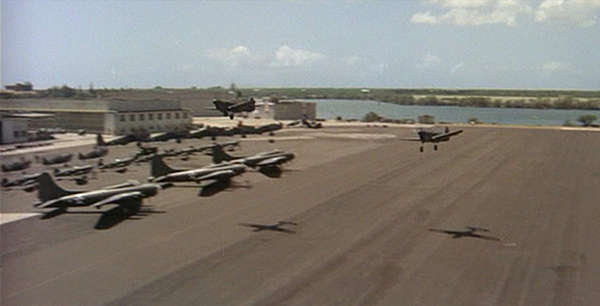
It is interesting to look at the back of the cutouts (the back of one is facing the camera) to see the support structure used to hold the thing together, as this enlargement shows:
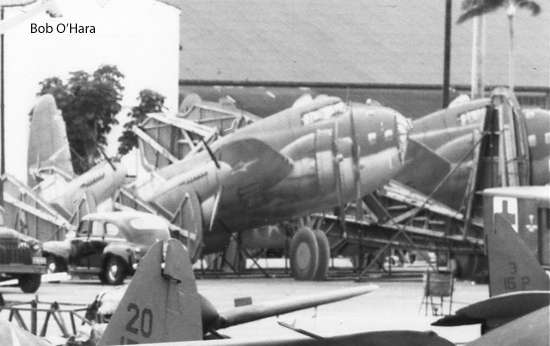
Five later series B-17 (one B-17F and four B-17Gs) air tankers were flown for the film, but the 'shark tail' B-17 cutouts are another indication of the lengths the Tora filmmakers went to to "get it right." Not that it was a "great" movie; it was instead a bit of a rarity in Hollywood (i.e. Pearl Harbor), it was an historically accurate movie. Just didn't sell too many tickets.
- David Braun put me in contact with Jerry Kitts, took these two cool photos of a Portuguese Air Force (actually, the Força Aerea Portuguesa--FAP) SB-17G in 1957 at the Lajes Air Base in the Azores. It was being used similarly to the USAF SB-17Gs, that is, for search and rescue. No external life boat is mounted; either it is missing or internal droppable inflatable rafts were carried at this point. Jerry noted in an email to me that:
At the time I did not know it was the only B-17 the Portuguese had. As I was stationed in the Azores (Portuguese air base #4) we shared air sea rescue with them and I have flown on this aircraft several times as a spotter looking for downed aircraft.
By the way, Jerry is associated with an interesting railroad model company in Willits, California, named The Foothill Model Works that bears checking out (apparently no airplanes, sorry). Jump here for the website. But here are the SB-17G photos.
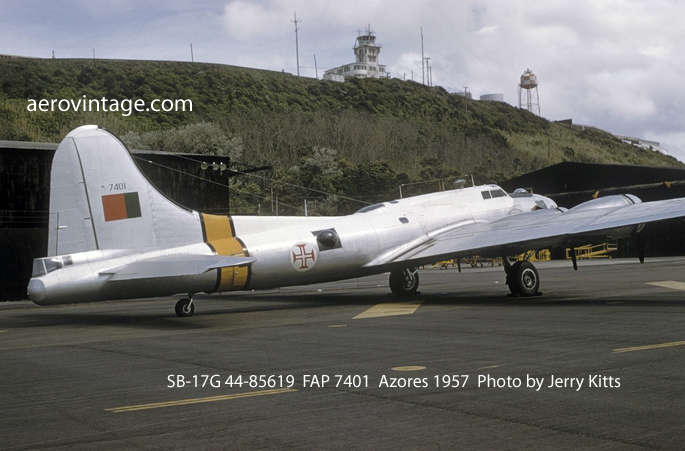
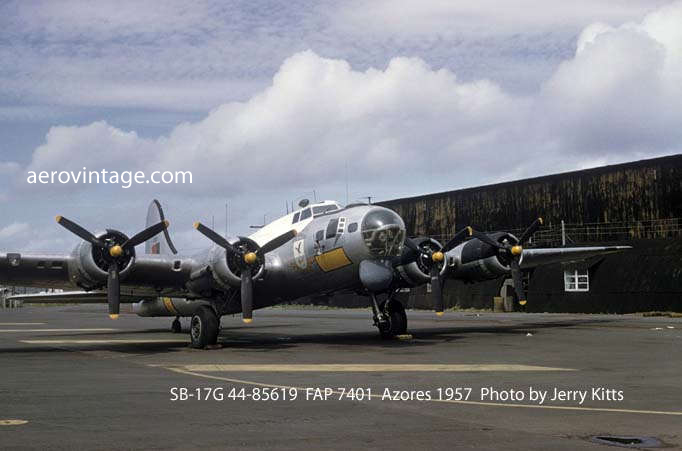
These depict SB-17G 7401, which is reported to be 44-85619, an ex USAF SB-17G. The FAP evidently operated five SB-17G between 1947 and 1960, carrying the serials of 7401 through 7404, with 7404 inexplicably being used twice. For the record, the reported tie up is
FAP Serial AAF Serial 7401 44-85619 7402 44-83712 7403 44-85548 7404 44-85519 7404 42-102732 From the AAF record card, 44-85619 was stored until 1947, then activated and sent overseas. There is no indication it was modified by the AAF or USAF to an SB-17G configuration, and it is shown the airplane as disposed overseas by the Foreign Liquidation Commission. In other words, it was transferred to the FAP. It is reported that this was the last FAP SB-17G in service when it was retired in 1960. No word on the fate of any of the five FAP SB-17Gs. Anybody have any info?
There is, by the way, the unanswered question about the sixth Portuguese B-17, that being 44-83842, that was interned at Lajes by the Portuguese government in 1948 while on its way to Israel. No further sign of that airplane, but one suspects it was disassembled for parts to support the FAP B-17s, and then scrapped.
- Phil Conley passed along these two photos showing the NMUSAF display of the vertical stabilizer of B-17G 42-97683. The display sign indicates it was shot down on March 15, 1945, while on a bombing mission over Germany. The tail section was recovered from a farmer's shed in 1996.
Doing a bit more research using Freeman/Osborne's The B-17 Story, the airplane was assigned to the 15th Air Force, 301st Bomb Group, certainly indicated by the "Y" on the tail marking. This airplane was delivered in January 1944, served with the 95th Bomb Group until it apparently was diverted to the Soviet Union in September 1944. It was eventually repaired and then assigned to the 301st Bomb Group in Italy and based at Lucera until its loss on March 15, 1945.
- An update on the Texas Raiders front as B-17G 44-83872 (N7227C) gets ever closer to getting some air under its wings. The Gulf Coast Squadron of the CAF got that much closer when more wing was mounted for that air. The left outboard wing section was recently remounted on the B-17 and word is that the right one is back on the airplane also. Added to the four mounted engines and props installed in the last few months, this is beginning to look like a B-17 again. Much work still to go...that annoyingly and painstakingly little stuff that no one sees but what keeps the airplane flying. No dates have been announced for flying this airplane, the first B-17 to be operated as a warbird (since 1967). Good for them: when you spend this much time, money, blood, and effort on a project, artificial deadlines are a mistake. I think the guys (and gals) want to do it right...credit their long view of opearating this airplane in the future. Kudos to that team.
Along the same lines, Don Price recently posted a photo of the chin turret for Raiders and it shows some of the challenges involved. There's corrosion work needed, plus some repair after earlier restoration efforts didn't maybe do such a hot job. More photos at a relevant topic at the Aero Vintage Forum.
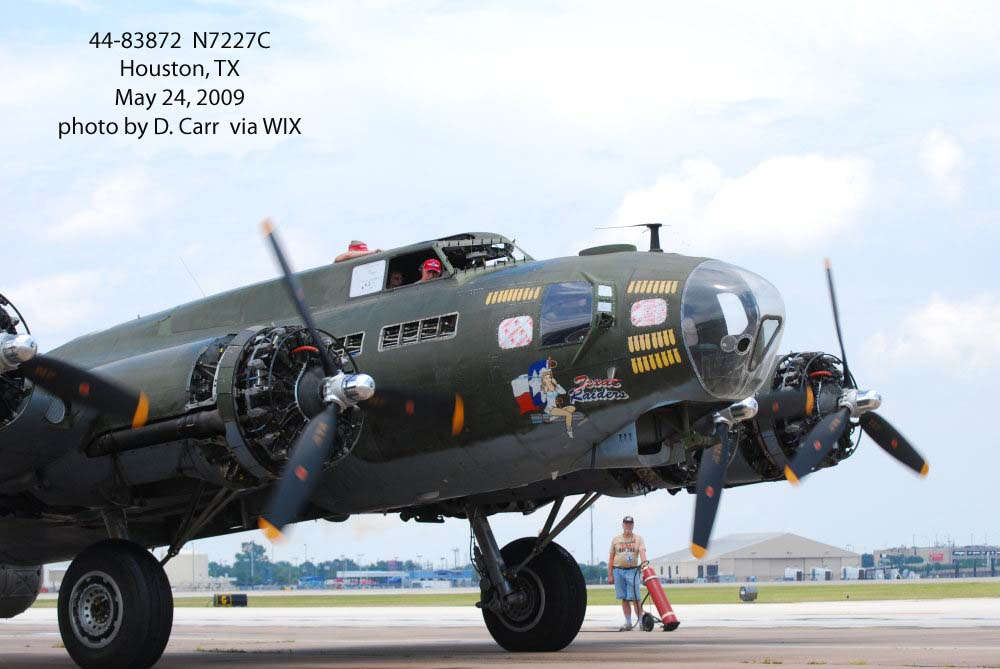
- Okay, then, an update on the Desert Rat front, that being B-17E 41-2595. Finally got a jig for the fuselage to make sure everything comes together lined up and straight. Bill Stanczak posted this and other information on another posting on the Aero Vintage Forum that goes into a bit more detail about this effort.
It is noted that Ray Moore built this jig for Mike Kellner and the Rat. Bill notes that Ray is "...the hardest working man in the business, who designed and precision built the jig based off drawings and measurements," which are nice words coming from a guy who works pretty hard himself in the business. See also below.
And here is a glorious shot of the nose as some of the skin work is being completed.
This, folks, is turning into a B-17E, for all those doubters out there. Go team, and kudos go to Ray Moore for the jigs.
- Speaking of Ray Moore, he is the gentleman who is piecing together a new-build B-17 that also incorporates the cast-off flotsam of leftover B-17 parts from other efforts and other spares. Just a bit ambitious, but those who know him say this is a viable project. Viability just jumped up a bit with Ray's own B-17 fuselage jig, a photo of which also appeared on the Aero Vintage Forum (you really gotta read that). Doesn't look airworthy in this photo but just add some bulkheads, some extrusions, some aluminum alloy skin and a few rivets, plus a bunch of determination, a huge phone bill, and more than a few dollars, and you might have a new B-17 fuselage structure.
As noted in the new third edition of Final Cut (you really gotta read that), Ray's effort is based at Inman, South Carolina, and he is bound and determined to put together a B-17. He and the Desert Rat guys and Tom Wilson, down at the Sugar Hill Institute of Technology, have formed a loose consortium of serious B-17 structure guys. (Coming soon: a new build B-17C.)
- Speaking of B-17Cs, for those of the Youtubular variety, here is something I missed that Dennis Coley made sure I didn't: a RC scale B-17C shown here during test flights: RC Scale B-17C Flying. Here is (I think) a photo of the same airplane that links to a website with more information:
Cool!
- Dennis also passes along a bit of information about B-17 crash site he recently visited in Florida. Here is a photo of some of what is out there:
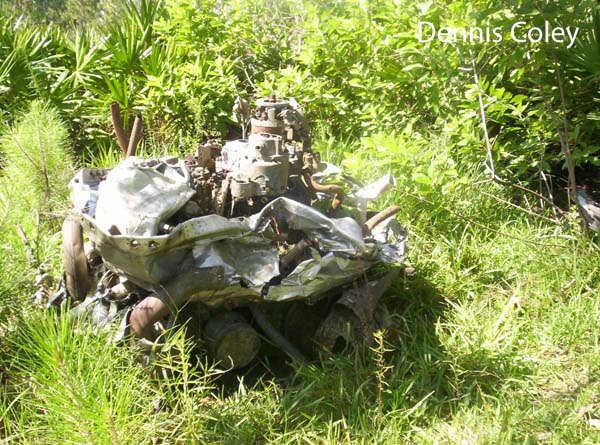
Dennis passes along this information:
This is one of the crash sites we visited at Avon Park Bombing Range a few months back. We don't have a positive ID on the plane. The staff at APBR excavated thecockpit area and recovered the ID tag, but they sent it off somewhere "higher up" and it never came back. It supposedly is in the Air Force Museum now. All they know is that the plane supposedly crashed sometime in 1943 and it had been rebuilt out of the remains of two damaged B-17s before it's demise.
- Under the better late than never department, my B-17 Locator page has long been missing a link to a photo of 44-83514 (N9323Z), otherwise known as Sentimental Journey. You'd think I'd have a photo of one of the most popular B-17s linked, wouldn't you. Well, thanks to Paul Gordon, finally put one up there. Here it is, by the way, a nice shot Paul took in September 2007 at Jeffco, or Rocky Mountain Metropolitan Airport as it is unwisely known today, near Denver.
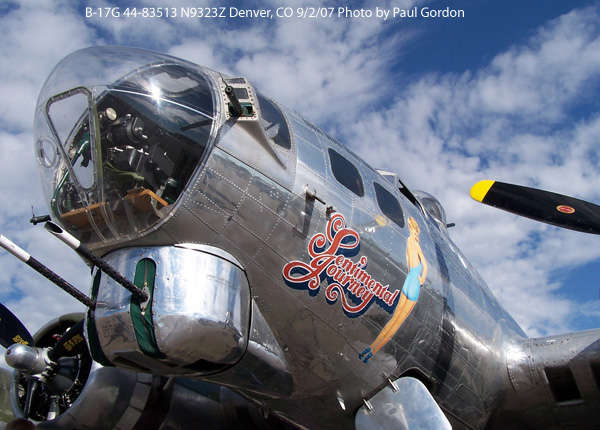
You can see more of Paul's photos right here.
- And that's it for this month...keep those cards and letters and book orders coming.
June 2009
- Progress continues on getting B-17G 44-83872 (N7227C) back into the air. Anyone following this continuing saga has to be impressed by the dedication of this CAF wing at Houston to get this B-17 back in the air. All four engines and props are hung and they all run at the same time! Here is a May 24 photo of the airplane with all four turning:
But for more fun, check out some of the You Tube videos of this B-17 going through some engine runs like the one here
These guys are getting closer.
- Tommy Clementzlor sent in a photo of one of the Swedish airliner B-17s from his collection:
This was a 94th Bomb Group veteran interned in Sweden in April 1944, then later turned over to the Swedish government for conversion to an airliner. It remained in service until 1948 when it was scrapped.
- Roger Cain attended a little event at the Schellville Airport in Northern California on April 13 that featured B-17G 44-85734 (N390TH) and it would be just wrong not to post a few photos:
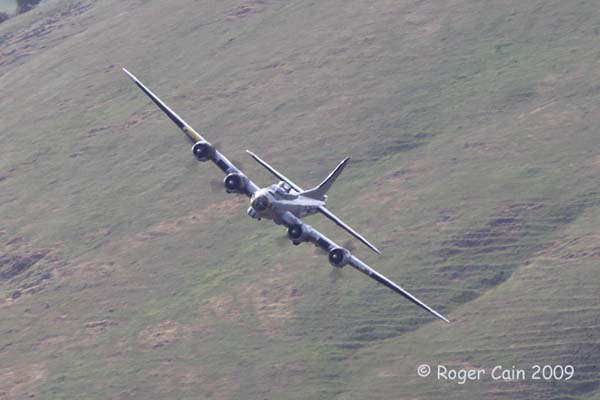
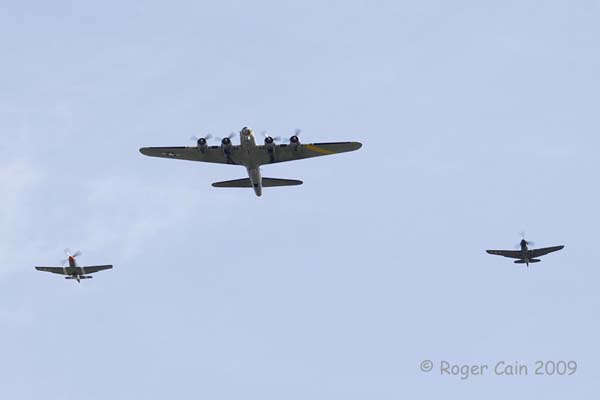
And though this is technically not a B-17, it is one great looking P-40N that did some escort duty:
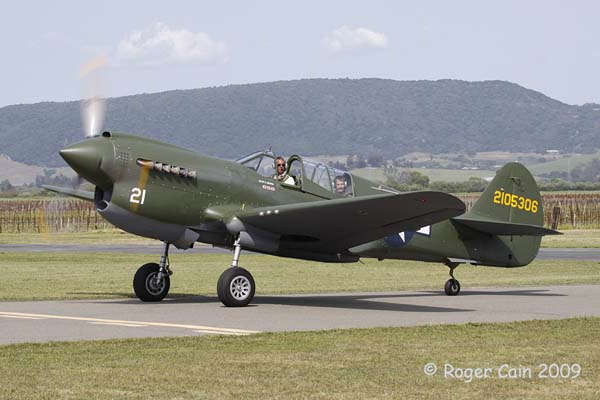
And, here are the B-17 perps now: left is Don Brooks, center is Ray Fowler, and right is Tom Wilson, who must have in hog heaven what with B-17s and P-40s about, eh? Yo, Tom!
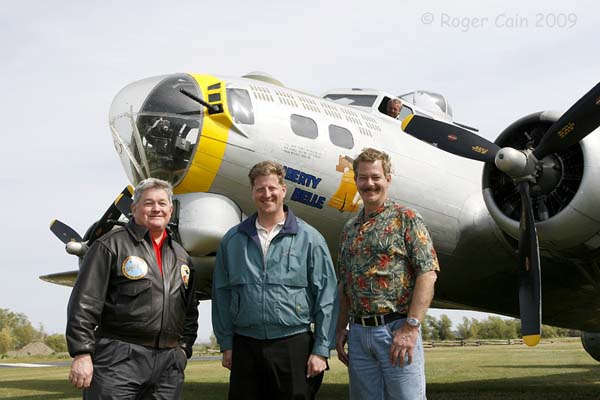
- Should mention the publication of a new book on the RAF B-17s that looks interesting. It is called Allied Wings 7: Boeing Fortress Mk. I which were the twenty B-17Cs passed on to the RAF in November 1940. Don't have a copy yet but I plan to.
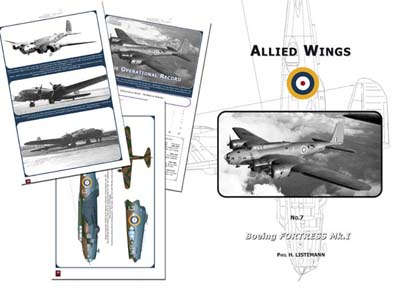
And here is a link to the webpage where it is offered. Forty pages long, it appears to take a good look at a fairly obscure use of the B-17 and its first real combat.
- Larry Johnson sent in this September 1979 photo of B-17G 44-85813 (N6694C) taken during its tanker days that I thought needed posting:
It was taken in Wyoming while being operated by Black Hills Aviation. It crashed the next year fighting a fire in North Carolina. Parts of it are being incorporated in the in-progress restoration at Urbana, Ohio.
- Posted recently on the WIX forum was a link to an Air and Space Magazine site with an unearthed Defense Department film that included details about Operation Snapper. Snapper was a 1952 atomic test series held in May and June 1952 at the Nevada Test Site (more details here) using fairly low yield nuclear weapons with part of the test used to determine blast effect on various parked aircraft. This test series is well known (not really) to extremely dedicated B-17-o-philes because a number of B-17s, including two surviving airframes, were used as targets in the test. Those two would be 44-83575 (N93012) now flying as Nine-O-Nine and 44-83722 not flying as anything but parts of which are being used to rebuild 44-85813 at Urbana, Ohio. Here's a view of the Urbana airplane after the tests:
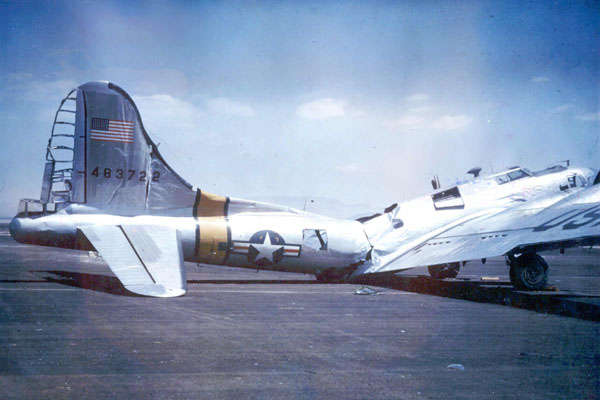
It would appear that this B-17 is seen in the DOD film as the nuclear blast hits, showing the tail feathers being shredded. The other B-17, 44-83785, fared a bit better and was bought as scrap in 1965 by Aircraft Specialties, who rebuilt the airplane to ferry condition and flew it to Mesa, Arizona, where it eventually became an air tanker. The rest is history and can be well-found in Final Cut. All the other scrap, including the other B-17s, but also including some B-29s, P-47s, and other types, was also sold as scrap in 1965 and presumably smelted into ingots. Here is one view of the scrap, this one including 44-83722:
And here is a shot of the 44-83575 being rebuilt in 1965:
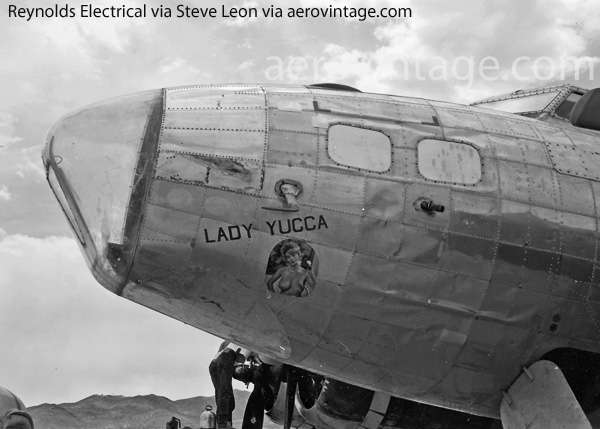
One wonders if any of the passengers flying these days on Nine-O-Nine know their ride was once the subject of four nuclear blasts and then abandoned as irradiated scrap. Should be okay.
April and One Half 2009
- Two little goodies have come to light that deserver some airing. The first is this photo sent to me by Tommy Clementzlor:
Tommy found the image on the web, not sure where, but this photo answers a couple of long-held questions about some B-17 parts held by the Yankee Air Force and Tom Reilly. This, evidently, is the rest of the story. The above photo depicts a surplus B-17G displayed at the Cooley Service Station at Heron Lake, Minnesota, probably in the late 1940s. The number on the nose almost certainly indicates this is B-17G 44-6237 as also suggested by the "BA-237" marking on the aft fuselage (this being a buzz code applied by the AAF in 1946 with "BA" being the code for B-17, and "-237" being the last three digits of the airplane's serial). There isn't another B-17G serial with the sequence of "6237" in it. A look at the listing provided in the Freeman/Osborne book The B-17 Flying Fortress Story tells that the aircraft record card for 44-6237 shows it delivered from Douglas in June 1944, then serving with several base units throught its service. Its last operational station was at Smoky Hill AAF, Kansas, in July 1945, then going to the RFC for disposal at Walnut Ridge, Arkansas, in November 1946.
If that account is correct, that is actually a bit of a late arrival at Walnut Ridge for RFC disposal, as by that late date the RFC had been supplanted by the War Assets Administration, and the thousands of stored aircraft at Walnut Ridge had already been sold to a smelting contractor months earlier in July 1946. (I would suspect an trnascribing error here: was the airplane actually at Altus??) In any event, the U.S. government was done with the airplane, and it should have been scrapped with 99.9% of its bretheren. But, here is where the story gets interesting. Based on some other evidence, 44-6237 was either purchased or made available on loan for display purposes by the WAA to the owner of a gas station at Heron Lake. The price paid was reported as $450, a bit low for either transfer given other similar transfers (such as Art Lacey's B-17 at Milwaukie, Oregon). It was disassembled and trucked to Minnesota and reassembled at the Cooley Service Station. Presumably, Mr. Cooley is the gentleman to whom the airplane was transferred, and an internet search suggests that the Cooley name is quite prominent in the Heron Lake and Jackson County area of Minnesota, located about 100 miles southwest of Minneapolis. (The population of Heron Lake in 2000 was 768 people.)
So, the available evidence indicates this airplane was displayed for a number of years at the gas station. After it wore out its welcome there, it was hauled off to a nearby farmer's field where it sat, quite neglected, and slowly lost parts and pieces. By 1984, it was just a shell of an airplane. The aft fuselage, from the about the radio room bulkhead to the tailwheel, was cut out of the airplane and went to a family for use as a storm shelter. The rest of the airplane was evidently scrapped shortly thereafter, though this is not confirmed.
The family buried the fuselage section several feet underground and used it for six or seven years as a storm shelter. Where exactly this was is not clear, but in the early 1990s, D. Troy Westum heard about the fuselage section and was able to obtain and recover the rather large section of B-17. He and his dad stood by while the previous owner dug the fuselage section back out of the ground with a backhoe and help load it on a trailer. This fuselage section eventually went to Tom Reilly at Kissimmee, Florida, where it was doubtlessly used in a B-17 restoration, probably that of B-17G 44-85734 that now flies as Liberty Belle. I'll need to ask Tom Reilly about where this section ended up because that really would be the rest of the story.
In the aftermath of the recovery, D. Troy Westrum wrote a short account of the recovery that appeared in the January/February 1992 issued of Air Progress Warbirds International. Also, the Yankee Air Force mined Heron Lake area for B-17 parts and reportedly came up with some smaller assemblies and control surfaces that might have ended up in B-17G 44-85829 that flies today as Yankee Lady.
By the way, the Westrum article notes that the only ID they could find on the part was the code "BA-23" on the outside of the fuselage section, obvious to me that the third digit "7" didn't make the cut (literally) when the fuselage was cut. Also, he notes that the number "1588" was found (on tags?) at two separate locations on the inside. The Douglas msn for this airplane is 22460, so I am presuming the "1588" is a subcontractor number for the section built by it.
Thanks to Tommy Clementzlor for bringing this to light, and also to Todd Hackbarth for some other details provided years ago.
-
The other item of interest is that, as noted in the April 2009 update below, the identity of the B-17B used as Mary Ann in the 1943 film Air Force was close at hand. It is now known that one (of either one or two) used as Mary Ann was s/n 38-584. Dan Johnson gets the credit on this one, and is based on a screen shot he pulled off the film, enhanced a bit and filled in:
Okay, filled in like this:
Now, I know the New York Times is not going to pick this story up, and when I tell people about this exciting bit of information they look at me a little funny. It is either they are hiding their own excitment really well or they don't understand. As a recap of what has been going on at the Aero Vintage Forum for the last year or so, is that this airplane carries a ficticious serial number in the movie, purportedly B-17D 40-5664.
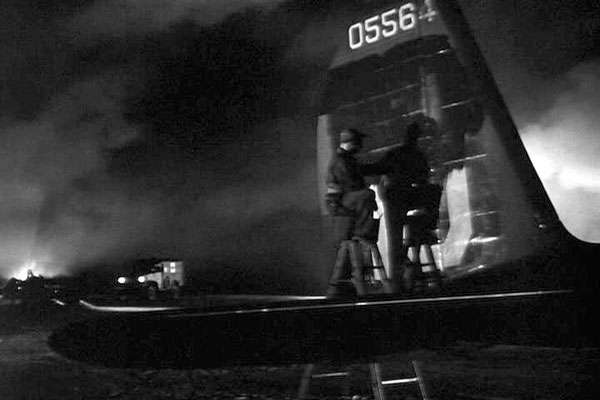
One can only presume the use of the higher serial number for a B-17D was an attempt to throw off any attempts by the enemy to gather information and also make it appear that more B-17Ds were built than otherwise suggested. In any event, the actual identity of the airplane has eluded serious B-17-o-philes, especially since the airplane is usually called a B-17C. It would appear that the Dan Johnson's identified scene above was shot either before the number was repainted on the airplane or the bogus number was only painted on the right side of the tail.
I would be remiss, by the way, if I didn't point out that in way back the June 2007 update I thought I identified the B-17B as 38-583, so I was only off by a brush stroke. Bummer. The Times would have been coming to me instead of Dan Johnson. I smelled Pulitzer but now only smell, but not badly. But I digress.
Bottom line it that there is now a great deal of information about this B-17B, other B-17Bs, some B-17Cs, and the film Air Force spread over four or five topics at the forum site, all topics worth reading for anyone with even a passing interest in the subject. A prime mover of this whole subject is a gentleman known to me as Dan K. (forum name "pokryshkin") who has taken information developed by Anthony J. Mireles (forum name "C-47B") and also Bill Stanczak (forum name "DryMartini") and run with it, pressing forward until Dan Johnson (forum name "Dan Johnson") finally got a definitive answer. There were others who contributed to this topic, some might call it a cult, but it is a nice result of some serious study. Thanks to all and I'm sure we are going to see more on this subject. Aero Vintage, now known as the place for information on obscure B-17 films made sixty-six years ago. Buy a book.
As a final note, there is more to gather about this film, particularly the role Paul Mantz had in the filming and a time line on the production. I'm sure some other contributors, including the likes of aviation film historian Bruce Orriss, will fill in some details along the way.
April 2009
- Sorry to say my computer burped a few weeks ago and I lost about five months of emails, including some items I was hoping to use here. Lost in cyberspace, as it were. Anyway, we do have some stuff and here it comes...
- Let's start the update off with information of the release of a unique catalog of new B-17 Parts available from Bill Stanczak and Mike Kellner, they of the restoration team putting together B-17E 41-2595 at Morengo, Illinois. Bill and Mike have been working on creating a supply of materials that, granted, will go into the B-17E but also will prove useful to anyone desiring to accurately restore a B-17, particularly those that might be flying again someday. Take a look at the catalog, linked below as a .pdf file, as it contains a growing number of extrusions listed by their "BAC" (Boeing Aircraft Co.) reference number. Yep, built to Boeing specs and will fit just like the original, airworthy to boot.
Slide the old damaged and corroded longeron out, slide the shiny new longeron in, rivet the bugger together and away we go. How about a new nose window frame for your restoration project: check out page 5. The last page has parts that are under development, like new wing spars. This is "gotta have" stuff for your B-17.
- Okay, speaking of Bill Stanczak, I would be remiss as an human being if I did not point out the drawing he posted to the Aero Vintage Forum page of the B-17C escape hatch that fits above the cockpit.
This held the aircraft commander's observation bubble and was mounted on the B-17B, B-17C, and B-17D in different configurations. Got a bit bigger and turned into a Sperry A-1 top turret on the B-17E. The aircraft commander had to find somewhere else to sit also. Now, if you have a really big magnifying glass and a great deal of talent, you can build yourself a B-17C escape hatch from these plans. Be the only guy on your block with one. Folks, you're just not going to find website content like this anywhere else so you should buy a book. What else can I say?
- Well, I have a lot more to say, sorry. Bill also reports that the engineering for the forms to make B-17C Bulkhead #10 for The New Build B-17C is underway. What new build B-17C, you might ask? Well, I say you haven't been paying attention. Scroll through months past and get with the program. Bulkhead 10 is an aft fuselage bulkhead at the forward end of the horizontal stabilizer. Now, you get Bulkhead #10 and connect it with Bulkhead #11 aft and Bulkheads #1 through #9 forward with a bunch of longerons and cover it with aluminum alloy skin and you have a B-17C fuselage. It might be a bit more difficult than that but that's the general idea.

Toward that end, Bill is looking for the following items to help in this regard: Search is on for 2017 or 2024 1.75" square tubes, I guess otherwise known as BAC1501-6898 and BAC1501-6902 and BAC1501-2921.
- Now, maybe I'm mining that B-17C hole too far, but I would be seriously remiss as a B-17-o-phile if I didn't post this photo that Bill Stanczak ran on the Aero Vintage forum.
Bill received the photo from Nick Veronico, who pulled it from his files and why didn't he send it to me also, I'd just like to know? Anyways, isn't this just a cool photo? It is a view from the aft fuselage (why, I believe that would be just forward of Bulkhead #10) looking forward. Good view of the waist gun installations and the lower gun emplacement. The forward bulkhead is between the waist area and the radio compartment, with the main entrance door on the right just aft of the bulkhead. The ladder is neatly stowed on the left side just aft of the bulkhead. This has to be a factory photo, given the pristene nature of the airplane. Someone noted on a forum posting that it looked as if the interior was painted, possibly silver paint. Maybe it is the type of film used or the lighting, but it does look like its painted. Anyone have information on how these airplanes were delivered, as far as the interior finish?
- Steve Birdsall sent in several items of interest. Among the first was this view of B-17G 44-8959 he sifted out:
The particular B-17 is shown here in India on May 1, 1945, with Lt. Gen. George E. Stratemeyer, and presumably was his personal transport. Stratemeyer was commander of the Army Air Forces in the China Theater with headquarters at Chungking from April 1944 until March 1946. The B-17G was delivered to the AAF in mid-February 1945 but details of its service are sketchy. One reference shows the airplane going the Navy in 1946, which is doubtful unless it was as spare parts support for Navy PB-1Ws. Anybody have the record card, per chance?
- The other photo Steve sent in was this one of B-17F Amarillo Avenger, an as-yet unidentified B-17F.
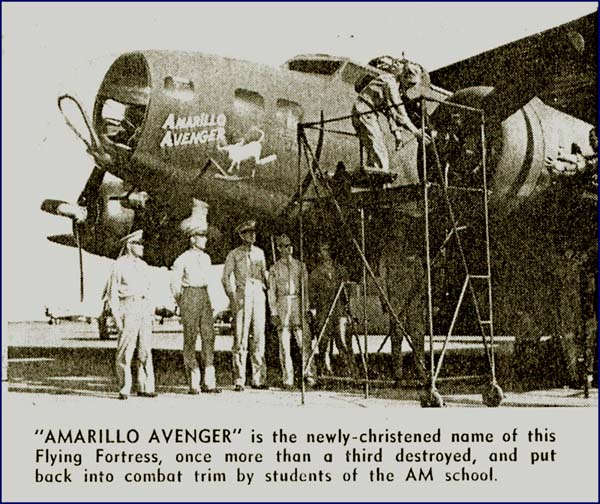
Steve relates that "the photo is a clipping from the November 1943 issue of The American Pilot. It's one of the early B-17Fs, but that's all I have." As Steve is the worldwide expert on early B-17Fs, I would not presume to dig into my scant files but will hope that someone out there might have a bit of information about this airplane. From the caption, though, I am going to guess that this was a "Class 26" B-17F sent to a technical school (at Amarillo, eh?) for work by budding aviation mechanics. I would also venture a guess that this was a 'returned from combat' B-17F that had a different name in service, that was badly damaged enough to be pulled from combat in the summer of 1943, patched together, and returned to the U.S. for assignment to a training role, re-evaluated and determined to be in too poor condition for that service, and then assigned to technical training at Amarillo ("AM"???) where it spent the rest of the war until it was scrapped. Just a guess, though.
A Wikipedia entry for Amarillo AFB notes "The field, one of the largest installations in the Western Technical Training Command, was established for training of air crew and ground mechanics to service B-17 Flying Fortress aircraft. From 1943 to 1945 basic training and special courses of instruction were conducted, and the school was later designated to train technicians for B-29 aircraft in addition to the B-17 technical training."
- Stephen Houseknecht gave me a heads up on this photo, copied from this Shorpy site (what is a Shorpy?), and is apparently of the Boeing production line circa 1943:
It is "Shop 301" somewhere, and I'm sure someone out there knows. I haven't seen this view before. Production line shots are always interesting. Note the olive drab tails on the nearly completed B-17s in the background.
- Brought forward on a WIX posting was this little fascinating bit about locating the crash of what is believed to be a B-17G, as yet unidentified, in an Icelandic glacier. Granted, this is not new news....this airplane was located in 2006....but a reminder of what is out there. Here is a link to the posting and here is a quote from that posting:
Here are some photos of B17G Cloister Easy which crashed into Eyjafjallajokull glacier in Iceland in 1944. They were on a ferry flight, heading for England, loaded with mail. Aperently they drifted off course and hit the glacier at an angel so all the 10 men survived the crash. The aircraft fuselage broke in two and left wing broke off and caught fire. The men left the wreack and shought shelter by rock formation close by. After they fire died out, the went back to the wreck and tried using there Gisbson girl radio to call for help, without luck.
The bombadeire blew the sabotage charge in the Norden Bombsight. In the night time they saw lights in a distance (a farm close by) and desided to climb down the glacier using parachute cord to tie themselfs together.
All the men were rescued and stayed in Army hospital for some time. Back in 1995 I contacted 4 out of the 10 men, including the Captain, who was living in retirement in Texas.
After the crash, the wreackeg snowed over and was not seen again until 50 years later. The global warming is melting the Ice in the glaciers, cousing the glacier "to return what it has taken" The wreakage has be mangeled by the ice.
Now, at the risk of enraging the internet gods, I also post one photo from that posting, completely and unquestionably sourced to that site, which I will take down if the enraged owners feel I should do so:
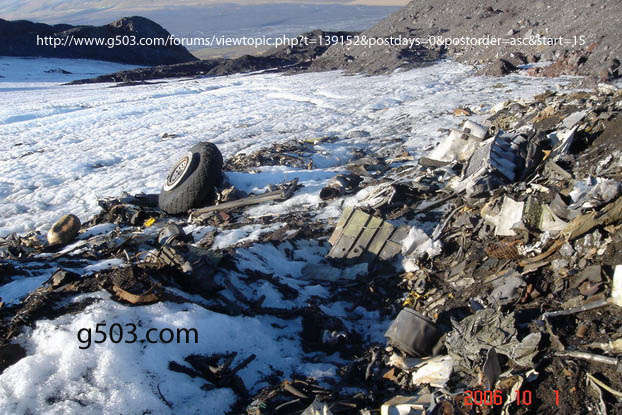
I wouldn't plan on putting this one back together.
- I should point out the continuing and fascinating series of postings contained in three topics lines under the Warbirds and Such Things forum on the Aero Vintage forum site. These concern the identity of the B-17B starring as the Mary Ann in the 1943 movie Air Force. There are several very detail-oriented sleuths that have been posting material about the film, about B-17B and B-17C serial numbers and aircraft history, and making some well-thought out conjectures about the identity of this B-17B. We've covered the topic a few times in months past here on the News pages, but here are a few highlights: It's always been "known" that the Mary Ann was a B-17C but now we know that it was actually a B-17B upgraded to the B-17C configuration. There was a Y1B-17 used in the film as one of the ten or so B-17s.
A summary, offered by Dan K., was posted as follows in early April:
To sum up what we know so far: 1:The film "Air Force" uses mostly modernized B-17B aircraft (and a single YB-17 in the opening flightline sequence as a backdrop for John Ridgely's walk out to his aircraft as well as in the initial takeoff sequence ), and was shot at Hendricks/Sebring between June and August 1942.
2:Aircraft seen in various sequences: "02", "05"(YB-17), "05"(B-17B), "07/"8261", "08"." "09", "10"/'05564'\????", "12", "15"/"9001", "16", "18"/"8211".
3: B-17B Aircraft known to be at Sebring/Hendricks during filming, June through August, 1942: 38-211"18", 38-212, 38-259, 38-260, 38-261"07", 38-262, 38-269, 38-270, 39-001"15", 39-003("10?"), 39-007("10?") ...and B-17D 40-3065, at Sebring from 6/20/1942 to 11/07/1942 plus a YB-17, (36-158 or 36-161) likely withdrawn to Class-26 in June.
4: B-17B aircraft lost after filming: 38-211"18" fatal accident 10/1942 38-262"??" fatal accident 4/1943
5: B-17Bs in non-fatal accidents : 38-269"??" accident 10/1942
6: YB-17s and B-17Bs to Class-26 Amarillo and dates sent there:
YB-17s: 36-149, to Amarillo 11/02/1942
36-151, to Amarillo 11/21/1942
36-154, to Amarillo 11/12/1942
36-155, to Amarillo 11/12/1942
36-158, to Amarillo 10/13/1942. possibly flightline "05"?
36-159, to Amarillo 11/19/1942
36-160, to Amarillo 11/19/1942
36-161, to Amarillo 10/09/1942, possibly flightline "05"?
B-17Bs: 39-003, to Amarillo 09/14/1943, possibly "10" "Mary-Ann"? 39-007, to Amarillo 07/16/1943, possibly "10" "Mary-Ann"
This view from the film, a screen shot posted on the forum, shows to good advantage the over-painted markings on the number four engine cowling, the scalloping no doubt the remnants of squadron markings carried earlier. These are the kinds of clues these aerial detectives are using.
There is also evidence that a second B-17B may have been used to fill in for Mary Ann during the filming, based on scenes where the airplane either does or doesn't have a white stripe on the tail and other small variances. The jury is still out on that one. I confess I am intrigued not only to find the identity of the airplane but also the interest this has generated. As this all boils down to the essence, I will update the Air Force movie page carried on the site.
- Another point of interest is a Desert Rat, otherwise known as B-17E 41-2595, newsletter that is being produced by Bill Stanczak and Mike Kellner. Here is what the first one looks like:
If you want to get added to the email list that receives the newsletter, jump to the Aero Vintage post and email Bill from there....that avoids some of the pesky spam issues.
By the way, the gist of the update is that work is progressing on the horizontal stabilizers for the B-17E as they are being rebuilt to airworthy standards. The B-17 horizontal stabilizer, as noted on the update, is wider than that of a T-6 wingspan. Big airplane, many rivets.
February and One Half 2009
- Okay, just got some photos I can't wait six weeks to post. These are from the Mighty Eighth Air Force Museum, courtesy of Brenda Elmgren, Chief Administrative Officer, who was kind enought to send them along. The first shows moving the airplane around a bit, the second and third show B-17G 44-83814 being reassembled inside the museum. See February below for more information about this airplane, etc.
- Speaking of new B-17 Parts (I wasn't, but am now), Bill Stanczak sent along an email detailing that the new B-17 Carry Through Spars he has been diligently working on for many months have been completed. Here is the gist of the message he sent along:
Yes, we finally have the carry through spars! We picked them up from the inspection firm this week, and are in the hanger. For those of you who did not opt for the cleaning/priming of the spars, we can now discuss how to get the material to you. For the rest, we are in the process of setting up for cleaning/priming, and should be ready for pick up in the next week or two.
This did take a little longer than planned, with the economy playing a part in it (as well as a furnace problem with the heat treater), but this is a bright day in the future of all B-17s.
So, if you ordered some B-17 Carry Through Spars from Bill, they are ready. And if you didn't, well, here's a bit a peak at the behind-the-scenes goings-ons in the world of B-17s.
February 2009
- Before we get started, I presume everybody has made the appropriate comment to the TSA about the Large Aircraft Security Program. If so, bravo! If not, well, for shame, for shame. This is an important thing or, as we say around the Aero Vintage Books head office, this is a very important thing. See my clever and extended comments in the 2008 B-17 News under December and also note what Benjamin Franklin thought of the TSA plans or just jump right to the government site to read all about the TSA plans to infringe on American Liberty here and take the time to make a comment here. What else can I say except don't be a weenie and the deadline is February 27. If you haven't commented by then, frankly, you can't complain when these onerous rules are implemented. I could say more but I'm kind of shy.
- Well, here we are in 2009. And we are starting the year off with notable news...another B-17 has emerged from long-term storage and will be placed on static display. The airplane is 44-83814, which last held the civil registration of N66571. The B-17G has been held in storage with the National Air and Space Museum since 1984, but was transferred to the jurisdiction of the Mighty Eighth Air Force Museum at Savannah, Georgia, in January 2009. The airplane has been physically moved by truck now, with the fuselage arriving at Savannah on January 14th. It is now being reassembled and prepared for indoor static display with the non-profit museum.
Here is a photo of the airplane as it was lately stored by the NASM:
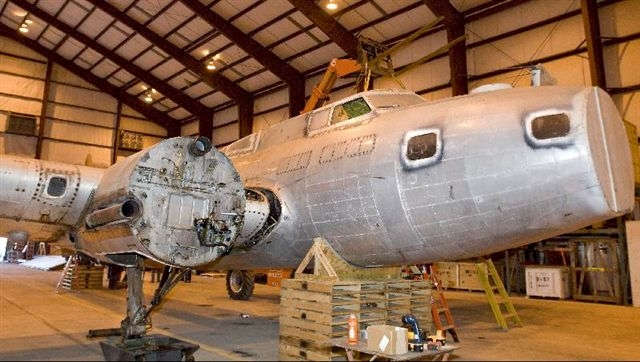
And here is a photo of the airplane arriving at the museum in mid-January:
The museum has been trying to acquire a B-17 since it first opened, as the type is synonymous with the focus of the musuem: the Eighth Air Force in service from England during World War II. The museum's president, Dr. Walter Brown, noted in an interview that the intent is to allow "school kids to get in it and see what it felt like for 10 men to get in a B-17 bomber for 10 hours." Hmmm. We shall see if a B-17 interior can withstand such punishment. Flak, yes, bubble gum, maybe not so much.
Also announced was that the airplane will be "returned to its original olive drab paint scheme." Well, aside from the fact that this particular airplane never was adorned with an olive drab paint scheme, Brown indicated it will be christened as The City of Savannah for the display. Cost of the restoration effort is estimated at $250,000 to $350,000 and take several months. The museum had another challenge in making a big enough opening in a wall of the building to get the fuselage and wings inside, where the parts will be put back together again. In summary, the good news is 1) the airplane is out of storage; 2) it is good and loving hands of a musuem that reaalllyyy wants a B-17; 3) it will be displayed indoors and protected; and 4) the focus of the museum well warrants a B-17 on display. By the way, the score sheet now shows five B-17s in long-term storage and four under restoration for static display.
- Okay, okay, so now everyone is muttering under their breath wondering about the history of this particular B-17, 44-83814. Where did it come from? How did it survive? What's for lunch? Okay, maybe not the last one, but it should be noted that this newest B-17 to emerge from the bowels of storage is actually one of the first civil B-17s that emerged out of the post-war storage yards. As well documented in Final Cut (Book Plug #1), this airplane was in the last batch of B-17s built by Douglas and accepted by the AAF on June 20, 1945 (five weeks after the end of the European war). It was flown directly to storage at Altus, Oklahoma, and turned over to the Reconstruction Finance Corp. for disposal. It was transferred by the RFC to a school district in North Dakota for educational purposes and was probably used at a school at Hazen, ND. It was "sold" by the school district to Owen Williams of California-Atlantic Airways. As a technicality, the school district didn't actually own the airplane (the feds held title) which they did not know but Mr. Williams did know. He also bought four other B-17s the same way, and managed to get civil registrations reserved from the CAA, with 44-83814 getting N66571 assigned. There were a series of lawsuits to determine ownership, but Williams sidestepped the one on this airplane when he sold it to Kenting Aviation at Toronto, Canada, in early 1953. With Kenting, a survey company, the airplane became CF-HBP and it began a near-two decade utilization as a survey aircraft. And, here is a photo from that period:
In April 1971, the survey role for CF-HBP ended, and the airplane was sold to Arnold Kolb, owner and operator of Black Hills Aviation at Spearfish, South Dakota. The FAA reassigned the old civil registration of N66571 to the B-17G. Kolb operated a number of B-17s as air tankers through the years and this airplane was also converted to the tanker configuration. Here is a 1978 view of the airplane operating as Tanker 09 at Omak, Washington, from the files of Mr. Tanker, Milo Peltzer.
Kolb eventually moved his operation to Alamogordo, New Mexico, and long about 1981, he traded N66571 to the National Air and Space Museum, getting a pair of Navy surplus P-2s in return. N66571 went on temporary display at the Pima Air Museum, Tucson, Arizona, until 1984, when it was delivered from Tucson to Dulles Int'l Airport by Arnold Kolb and his son. And then it was mothballed and rolled into the bowels of the NASM, never to emerge again until January 2009 when it was rolled right out of the bowels and then rolled right on down Interstate 95 to Savannah. Happy ending.
- Speaking of said Owen F. Williams, is there anybody out there who knows anything substantial about this guy? He was a major player in the 1950-1955 time period not only with B-17s but other future warbirds also. He owned and ran California-Atlantic Airways at St. Petersburg, Florida, during that period and it is confirmed, as per Final Cut (Book Plug #2), that six B-17s passed along through his company: N66568, N66570, N66571, N66573, N66574, and N67974. Most of these B-17s were rounded up in the 1950-1952 period from schools that had received educational transfers from the RFC in 1946 and 1947. Very little is known about either Williams or his company. Those who might be able to fill in a few holes can contact me.
- Coincidently, Dave Hatfield has been in contact with me as his father flew another of the Kenting airplanes, this one being B-17E 41-9210 (CF-ICB), during the summer of 1960 doing photo survey work in the Arctic for topograhic charts.
Dave passes along a bit of information on Kenting and their B-17s, thus:
Kenting Aviation, a Canadian aerial survey company, operated a number of WWII aircraft up until the late 1960s, including this B-17G, as well as a B-17E. This photo was taken in the Canadian Arctic in about 1960, when the aircraft was based at Thule, but often ended up on the gravel strips more prevalent at the time. It's duties involved photo runs at up to 32,000 ft, which was a strain on the engines and crews -- the B-17E changed 10 engines that summer, and the crews sometimes got the bends. The surveying was remarkable in that often there were no maps for the Navigators to use to plot the photo lines. Only the coastlines were charted. They had to make rough sketch-maps as they went in order to establish a method of paralleling the track on a 9-mile grid -- sketching maps in order to make maps! It was pioneering work. And demanding, too: the IAS at 32,000 ft was only about 110 kts, and the controls on a Fort are on no way boosted. The headings and bank angles had to be kept accurate to within a degree, and some missions went over 10 hours. The Autopilot was of no value up there, at the "edge of the envelope". All hand-flown."
- While we are on the subject of B-17E 41-9210, now registered as N12355, Ralph Pettersen recently passed along to me some photos he took at Arlington, Washington, in September 2005 while parts of the airplane were on nominal display at the Flying Heritage Collection facility. The B-17E flew to the Arlington in May 1999, rolled into a hangar and then disassembled for a complete restoration. The museum has since moved to Paine Field at nearby Everett but the actual location of the B-17E is thought to still be at Arlington. I tried on several ocassions to contact anyone connected with Vulcan Warbirds (owner) or the museum in trying to update Final Cut (Book Plug #3) last summer but no one would talk to me. Seems kind of like the Punk Works to me but, hey, I'm not paying the bills. Anyway, Ralph took some great photos of an incredible rebuilding effort. These parts appear to be better, far better, than new.
- Steve Birdsall recently dropped in an interesting Duane L. Zemper photo of brand new B-17G 42-32051 being delivered to the 457th Bomb Group, Eighth Air Force in England in early 1944.

A great photo in and of itself, it also is of interest as this airplane came down the Boeing line at Seattle a day or two before 42-32076, it being 25 airplanes newer. The latter airplane is, of course, the vaunted Shoo Shoo Shoo Baby, displayed at the NMUSAF at Dayton since 1988 but destined soon enough for the NASM. Steve's point is that this is what Shoo Shoo Shoo Baby looked like upon delivery as one of the first unpainted Boeing-built B-17Gs. It's been a bit of a chew for many that the airplane was finished in the AAF olive drab and grey camouflage, as this finish is grossly incorrect.
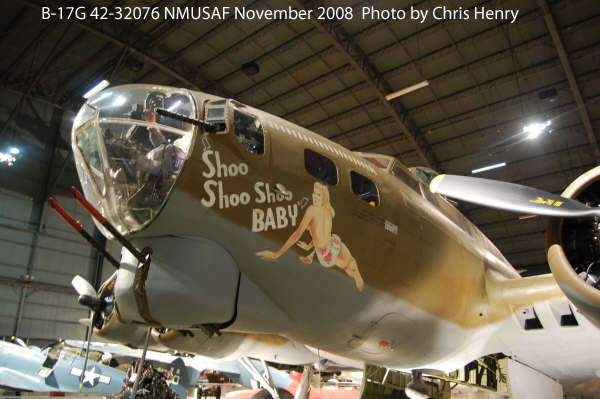
At the time, the public word was that the restoration process on Shoo Shoo Shoo Baby, with all the skin patching required, necessitated it to be painted. That was then (mid-1980s) and it is doubtful such a decision would have been made today. However, it is also interesting to note that several of those involved in that restoration recall a bit more of the story. In this fuller version, one of the wartime pilots of the airplane, then Lt. Paul McDuffee, was consulted extensively during the restoration. According to him and his memory of some forty years earlier, the airplane was finished in OD camouflage as was named Shoo Shoo Baby (two "Shoo"s and not three), despite photographic and other evidence to the contrary. Like this one, courtesy of Steve Birdsall:
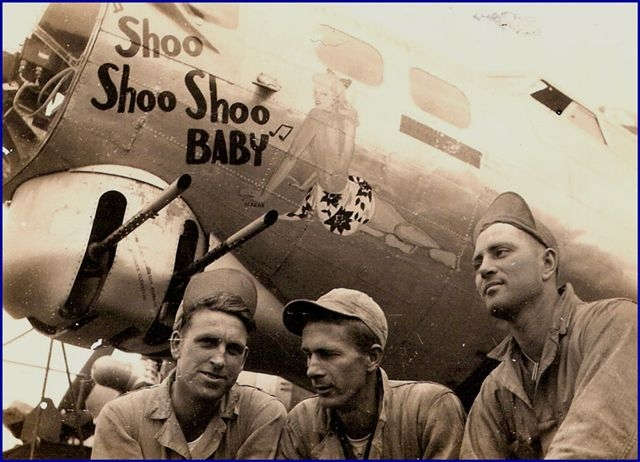
For whatever reason, his views prevailed and the result is what we have today. It is also rumored that the airplane was actually finished as Shoo Shoo Shoo Baby by the original artist (Tony Starcer) after it was painted, but as a concession to McDuffee, the third "Shoo" was covered up by an OD panel until after he passed. We salute and respect Lt. McDuffee for his wartime service, but it is too bad the airplane lost a bit of its displayed authenticity to what can only be ascribed as a faulty memory. Enough said, maybe too much.
- Speaking of Steve Birdsall, he lent his files and expertise to an effort by Justin Taylan, he of Pacific Wrecks, to create a DVD documentary telling the history of B-17F 41-24521, otherwise and better known as Black Jack. This particular B-17 is of interest as it is a combat veteran that survives to this day, though it happens to be underwater near Boga Boga in Papua New Guinea. The airplane ditched after a combat mission on July 11, 1943. This DVD is very informative and I'll feature a review of the DVD on my Review page at some point in the future. Meanwhile, to whet your appetite, Steve passed along this photo:
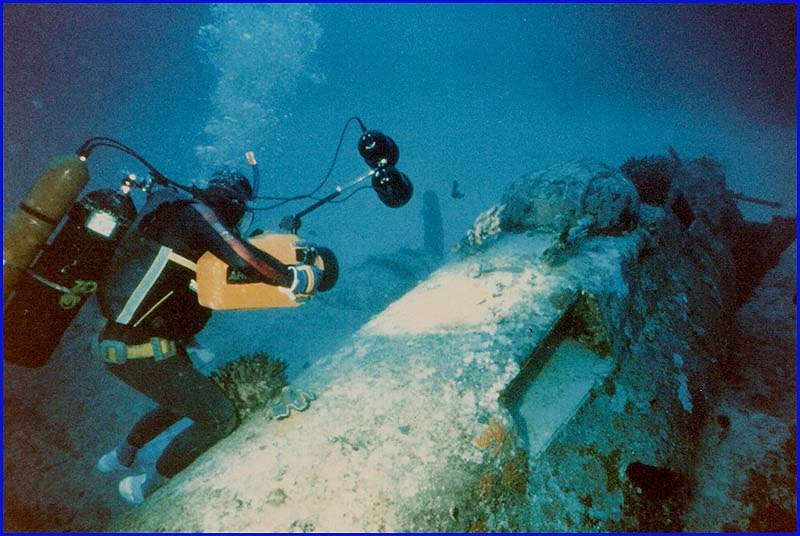
Steve describes the photo as follows:
Here's a photo that might be of interest - it shows the bulky Arriflex 16mm camera and housing that Russell Galloway used to film Black Jack. Russell shot almost all the underwater footage, but safety considerations restricted him to one dive with about 15 minutes bottom time per day. To maximise use of the equipment, divers Pat Manly and Bradley Strohfelt also shot some film, mostly detail shots in and around the old plane. The photo was taken by Lyn Manly.
Yep, that's a B-17F. Probably not gonna be a flyer, for those pre-loaded to recover such artifacts. Better left where it is, in my humble opinion which, granted, no one asked for. Still, this is one gotta-have DVD for all that read these pages. Here is what the front of the DVD looks like:
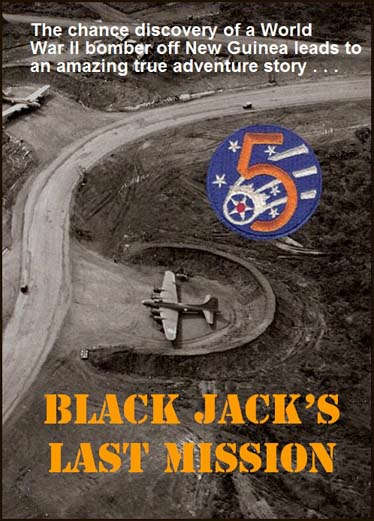
May I suggest to one and all that they jump to this Black Jack's Last Mission page for more information about this DVD.
- Okay, for those on the active and realism side, have we got a deal for you. The Collings Foundation has announced a World War II Crew Fantasy Camp. Now, for starters, this has nothing to do with Betty Grable. Okay, but have you ever dreamt of becoming part of a bomber crew and flying a mission? This, buddy, is your chance. During the weekend of May 26th and 27th, the Collings B-17G 44-83575 (N93012), otherwise known as Nine-O-Nine, and that other airplane (the B-24) are going to based at Stockton, California, and particpate in a fantasy weekend. The chosen few who have chosen to sign up will undergo a training session for each of the crew positions (gunners, navigator, bombardier, pilots (sort of)), and then get the opportunity to fly a mission with an escort of a P-51C and under the attack of an Me-262. Real bombers with gun turrets and machine guns, bombsights, interphones, yelling, oxygen masks, cold air, turbulence, squinting into the sun, bandits and bogies, maybe even C-Rations. No real bullets or blood, though. Reality and fantasy....gotta keep 'em separated, you know. Right now the Collings group says only the -24 is participating but we think the -17 will be there too. For more information, you need to check out this Collings web page or call 800-569-8924. Say hi for me.
By the way, the Collings Foundation is selling the brand new third edition Final Cut (Book Plug #4) on the tour that just started. Shows the kind of good judgement the group has, eh? I'm so funny.
- Using my magic time machine, we now go back, way back, to October 2008 when this was posted on B-17 News:
The second one shows what might be B-17G 44-8467 undergoing some maintenance with, again, date and location of photo unknown. The record card for serial 44-8467 shows the airplane operating domestically after its September 1944 delivery. It was out of service by January 1946 and scrapped at Walnut Ridge. The "BA-467" buzz code on the aft fuselage was part of a system adopted in October 1945. That would rule out the airplane being 43-38467 (lost in February 1945), the only obvious other serial number that might cover the airplane. The insignia near the belly hatch appears to be Eighth Air Force and the airplane appears to be marked as
The Volunteer. Any other information out there? Well, Bob Tally sends via email an interesting observation based largely on factual fact:
Concerning a picture "Dan" sent in which everyone thinks the serial number ends in 8467; is actually 3467. Looking at the top of the number you can see that the left side angles down sharper then the right side. Also, the middle line stops before reaching the end of the picture. The top left of the "3" will look like the top right side of the "6". Hope this helps in identifing the aircraft.
Well, Bob, we thank you for your eagle eye and letting us know, because it probably is "3467" ....but everybody should note that I was, in fact, right about the "467" part. The airplane might , in fact, be 44-83467. That particular airframe servied in various base units at Peterson Field, Colorado; McDill Field, Florida; Ft. Worth, Texas; Kelly Field, Texas; and Tinker Field, Texas. The airplane was salvaged by March 1949. Beyond that, no information, but this could certainly describe this airplane. The history of this airplane is courtesy, by the way, of the fabulous Freeman/Osborne book The B-17 Story.
- Nick Veronico passed along a neat little photo taken at NAF Litchfield Park, Arizona, during the filming of Lady Takes a Flyer around 1958. In the background is a surplus Navy PB-1W, serveral of which can be seen in the completed film. This film is a bit unique for the time period it was shot and features a USAF VB-17G in the opening scenes, plus the stored PB-1Ws, plus the assorted surplus PB4Y and B-25. Catch it if you can...
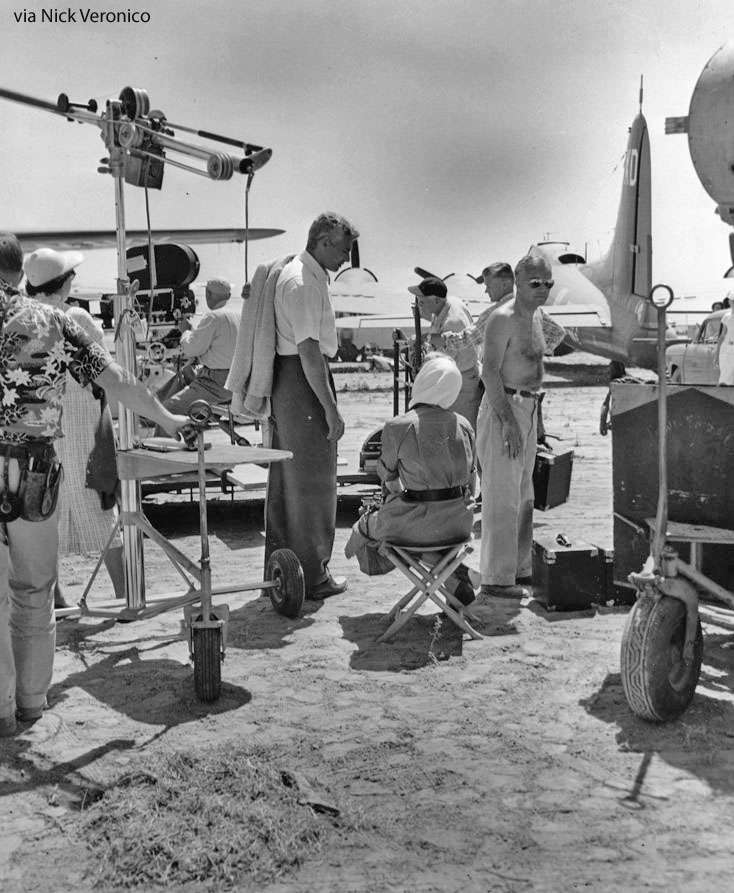
Those are stars Jeff Chandler and Lana Turner in the foreground (Lana has the scarf on; it was probably hot) but I'm pretty sure the photographer took the photo because of the PB-1W. Pretty sure.
- Bill Stanczak and Mike Kellner have come up with a cool little idea: they have been able to construct a wooden model vary similar to the one being used by B-17 engineer Ed Wells as depicted in the first photo. Bill is considering offering these wooden models for sale to those B-17 aficinados who want something a bit different. Plus, if things work our right, some of the profits from the sales would help support the restoration of the B-17E 41-2595, otherwise known as Desert Rat.
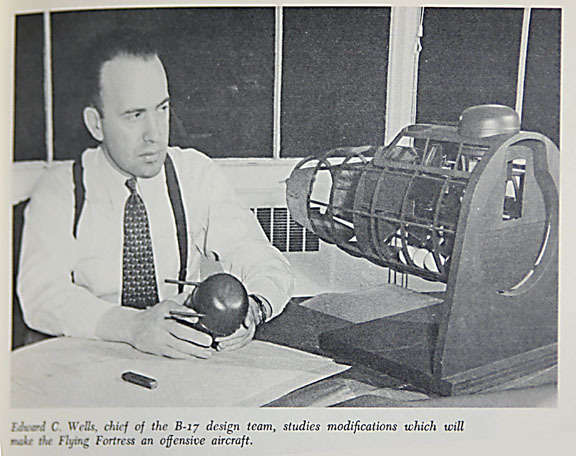
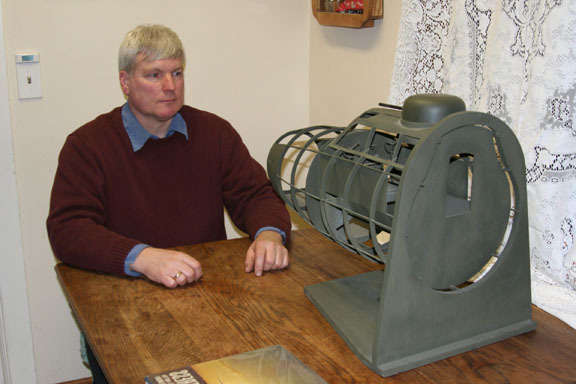
(Modeled by Mike Kellner)
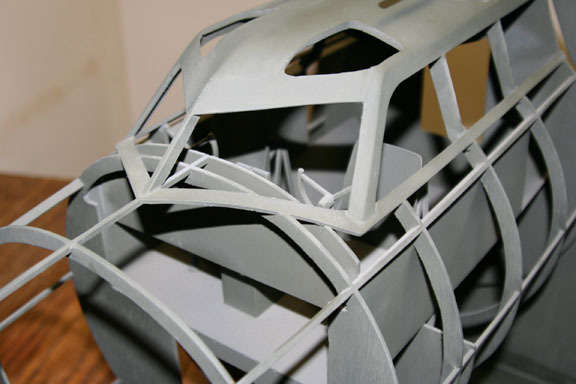
Planning is in process, but consider it. If anyone wants more information, email Bill via the Aero Vintage Forum. Here is the posting that offers this model and the possibilities. Coo-ol!
- The Smithsonian's Air & Space website has a feature article (from the November 2008 issue...okay, I'm slow) on the NMUSAF's restoration of B-17F 41-24585, better known as the Memphis Belle. Nothing really new in the article....at least for those in the "know." As usual, the article incorrectly states that the B-17 was bought in 1946, this time by the mayor of Memphis. I defy anybody to find any one case where any one B-17 was sold as surplus by the U.S. government for $350. The $350 was the transfer fee charged by the RFC to allow a city or educational institution to get a B-17 for display or other uses, and this is verified by numerous documented cases and is in the RFC regulations themselves. Title was retained by the U.S. government, which is why the NMUSAF could go to Memphis and say "Hey, we want the plane back. Sorry." Thanks to Pat Carry for the head's up.
- Speaking of articles, would I be remiss to mention the February 2009 issue of FlyPast Magazine on the Fulton Skyhook B-17G, 44-83785 (maybe) now held by the Evergreen museum at McMinnville, Oregon? I won't say who wrote it but he's pretty close at heart.
That article elicited the provision of this current photo of the airplane as it is displayed, courtesy of Don Arner, a docent at the museum:
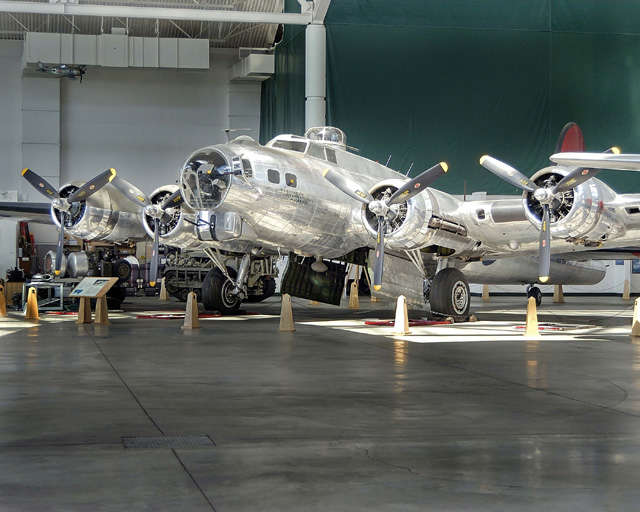
- Along the same lines and in regard to the "Spook" B-17s (which is what the article in Flypast was about), comes this excerpt, also provided by Don Arner, from the newsletter of the Air Force Navigators Observers Association (cleverly named DR AHEAD) and written by Eugene Scalise detailing another little secret mission undertaken with B-17s during the Korean War:
Another little piece of the puzzle comes to light, eh?
- Step back, if you will, into my time machine again for this photo of the United States Air Force Museum in an earlier era, back when it was on the other side of the base, back in the late 1950s or early 1960s, back when vintage airplanes were just old airplanes, back when they were mostly outdoors, back when....well, you get the idea. Great photo, and yes, that is a B-17 at the right, specifically DB-17P 44-83624 not far removed from the flight line at Eglin AFB, Florida. It now resides, by the way at the Air Mobility Command Museum at Dover AFB, Deleware, as clearly outlined in Final Cut (Ooopps.. that would be Book Plug #5 :
- Okay, too cool not to post, even if it is "borrowed" from the WIX forum:
Yep, a gen-you-ine B-17B, Boeing built and Boeing backed. Back at March Field in 1940, back when men were men and, uh, well, I guess airplanes were airplanes. Anyway, a bunch of good color is surfacing from beneath the morass, coming from the files of Life Magazine. Double Cooo-oool! What else can you say?
- Well, that's it for another month, but isn't that enough? Two questions in a row. Bummer.
- Nick Veronico passed along a neat little photo taken at NAF Litchfield Park, Arizona, during the filming of Lady Takes a Flyer around 1958. In the background is a surplus Navy PB-1W, serveral of which can be seen in the completed film. This film is a bit unique for the time period it was shot and features a USAF VB-17G in the opening scenes, plus the stored PB-1Ws, plus the assorted surplus PB4Y and B-25. Catch it if you can...
B-17 News Archive
2018 B-17 News
2017 B-17 News
2016 B-17 News
2015 B-17 News
2014 B-17 News
2013 B-17 News
2012 B-17 News
2011 B-17 News
2010 B-17 News
2009 B-17 News
2008 B-17 News
2007 B-17 News
2006 B-17 News
2005 B-17 News
2004 B-17 News
2003 B-17 News
2002 B-17 News
1997-2001 B-17 News
Back to B-17 Information
Back to the Main Page
Updated: - Progress continues on getting B-17G 44-83872 (N7227C) back into the air. Anyone following this continuing saga has to be impressed by the dedication of this CAF wing at Houston to get this B-17 back in the air. All four engines and props are hung and they all run at the same time! Here is a May 24 photo of the airplane with all four turning:
